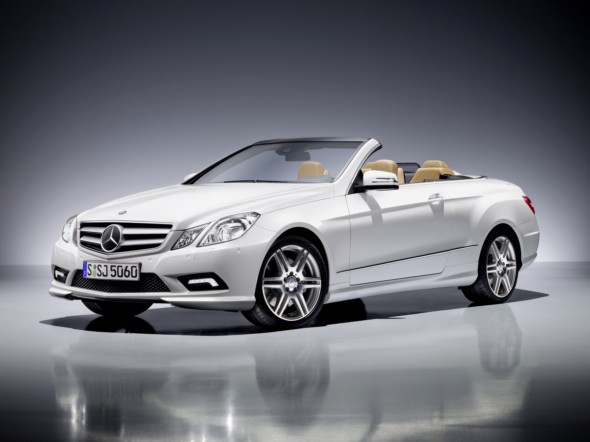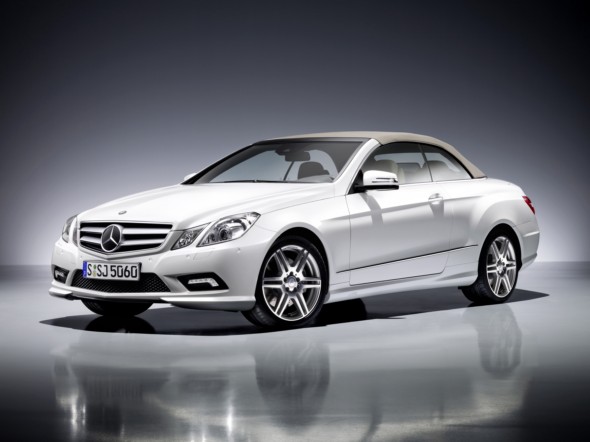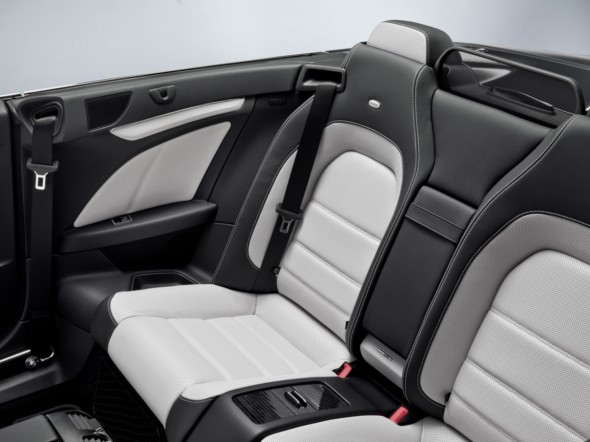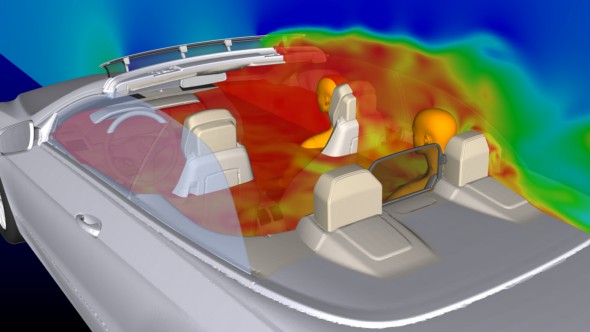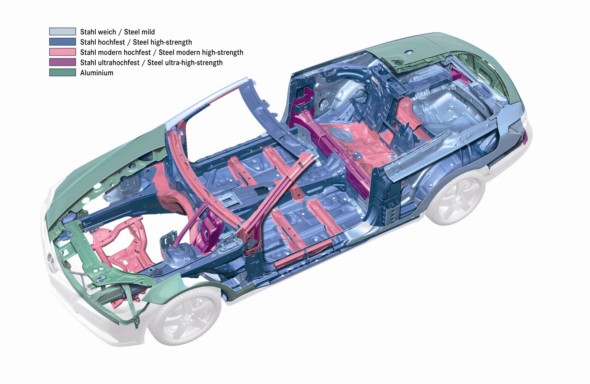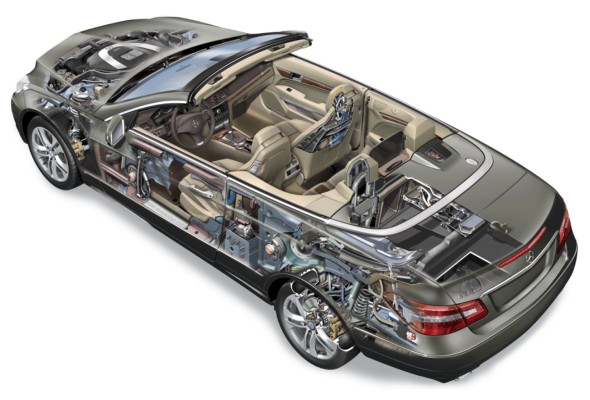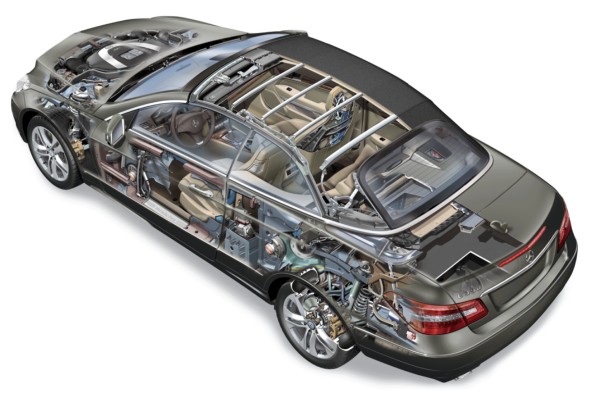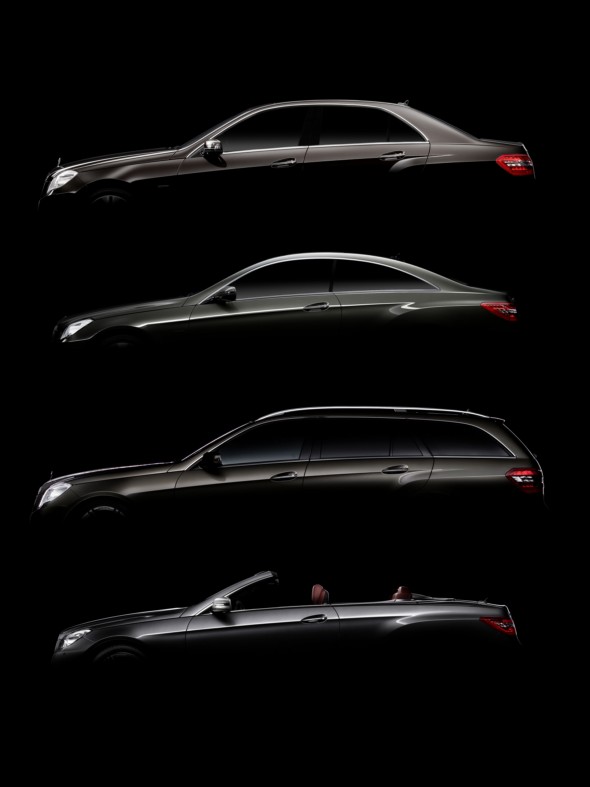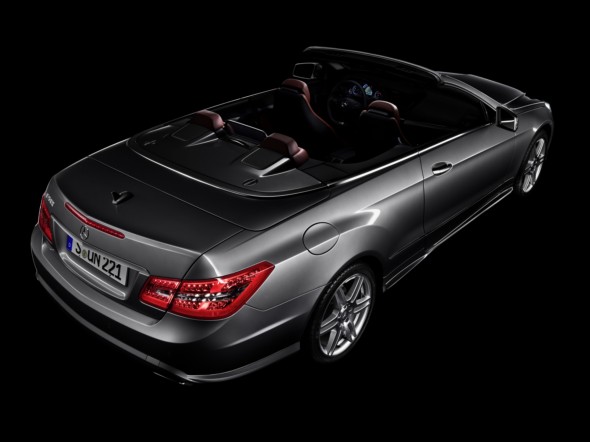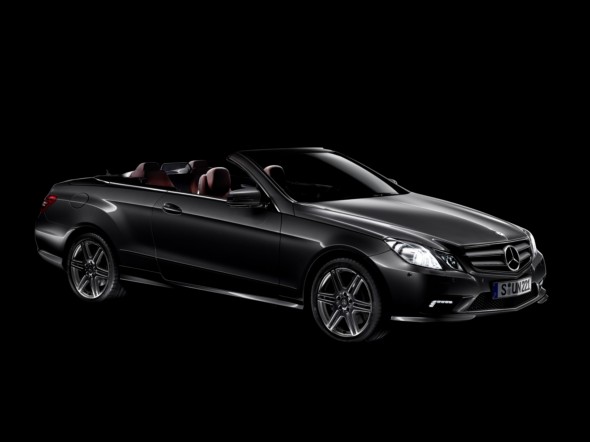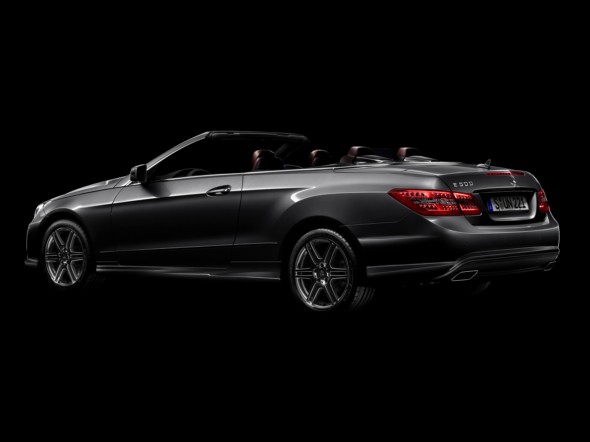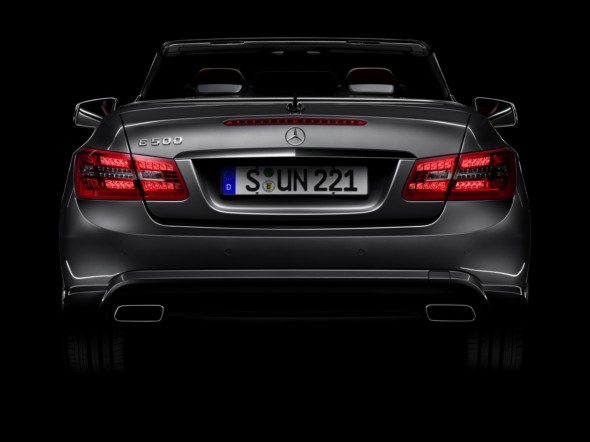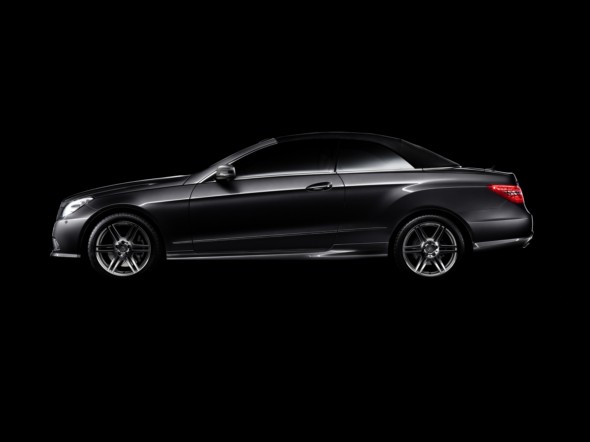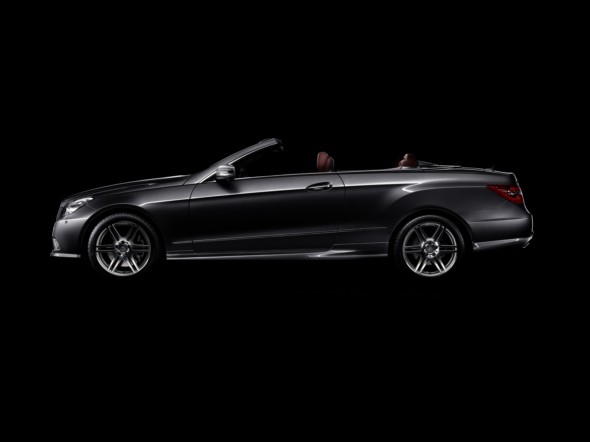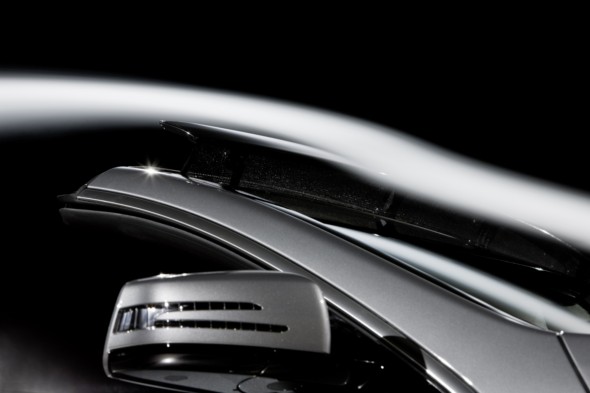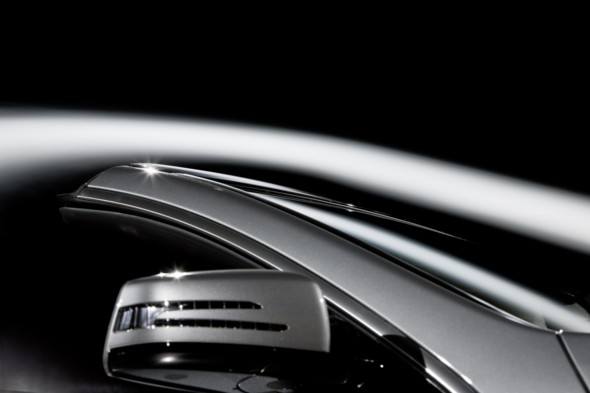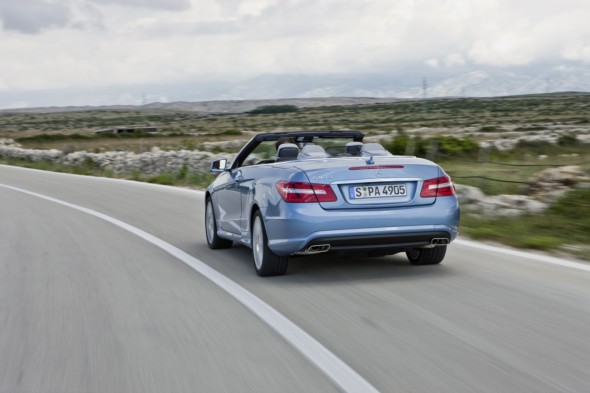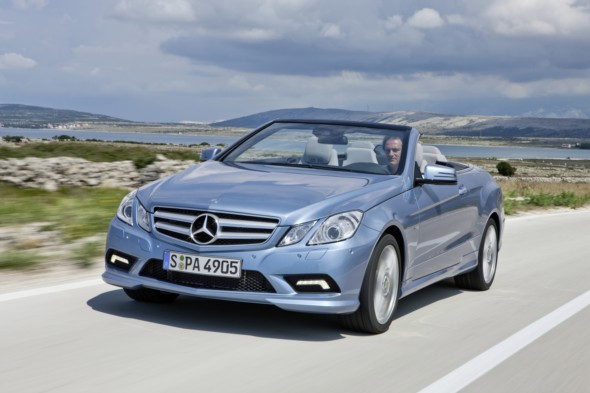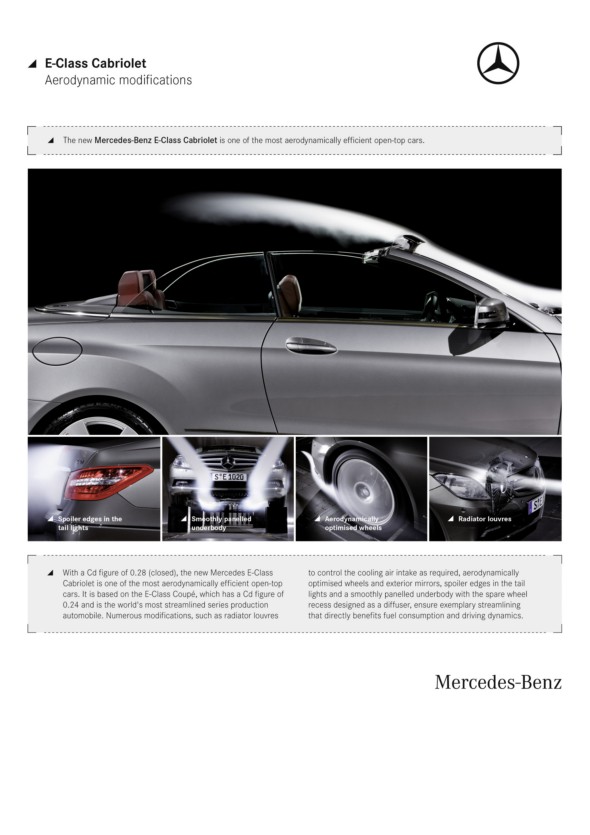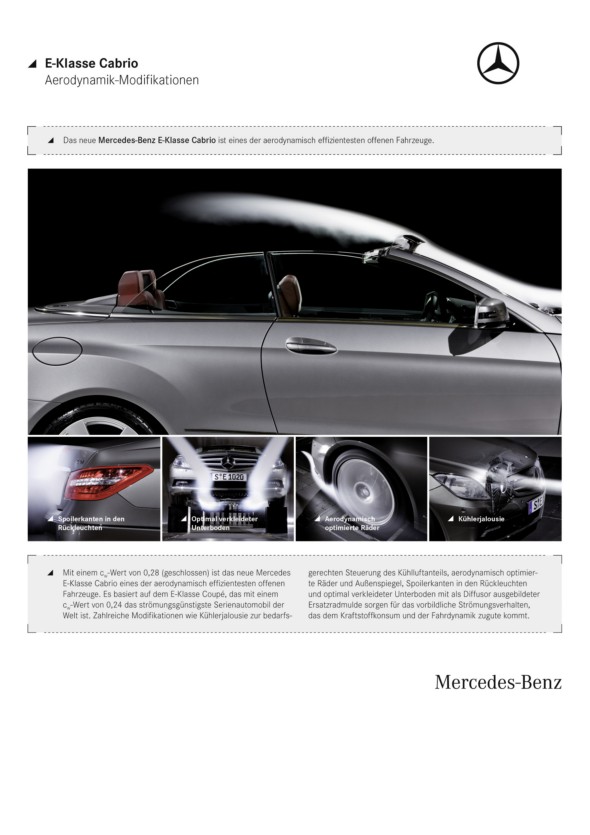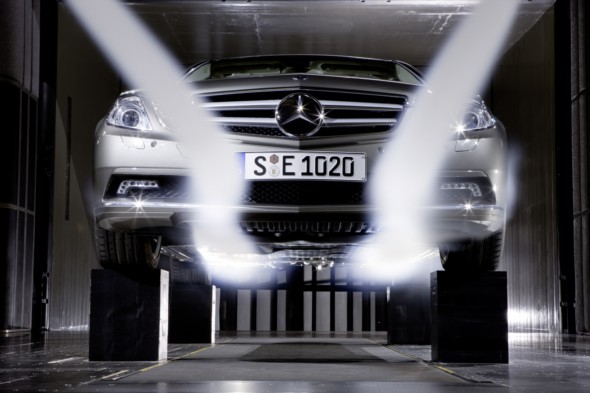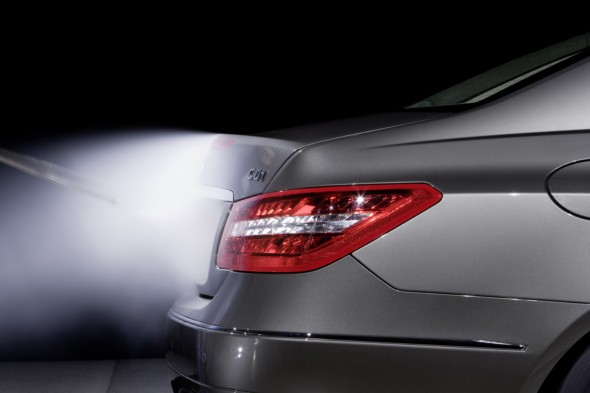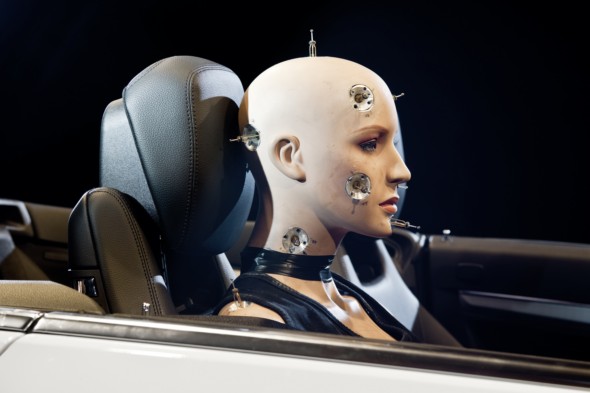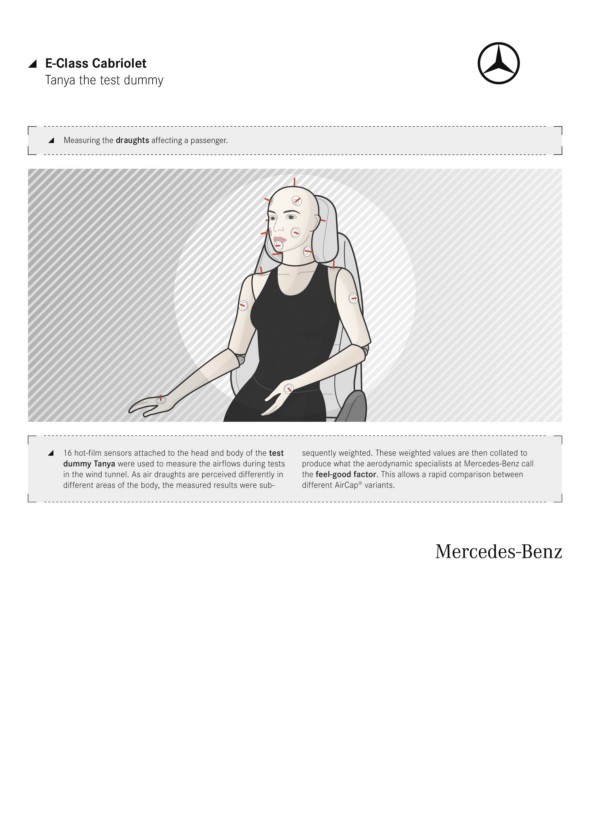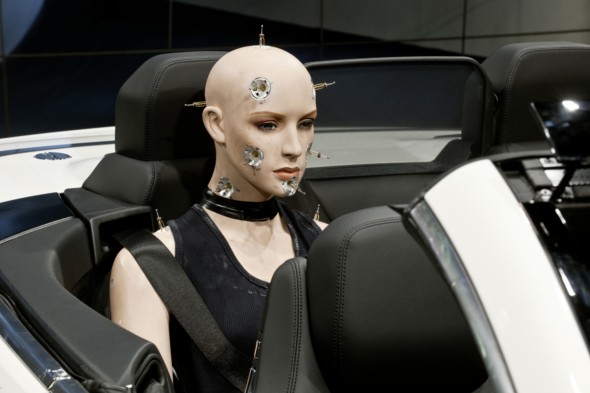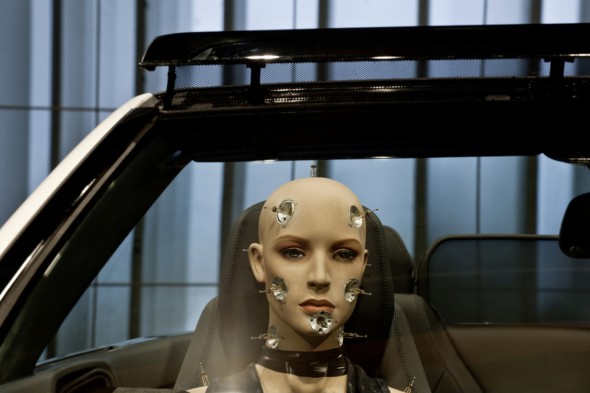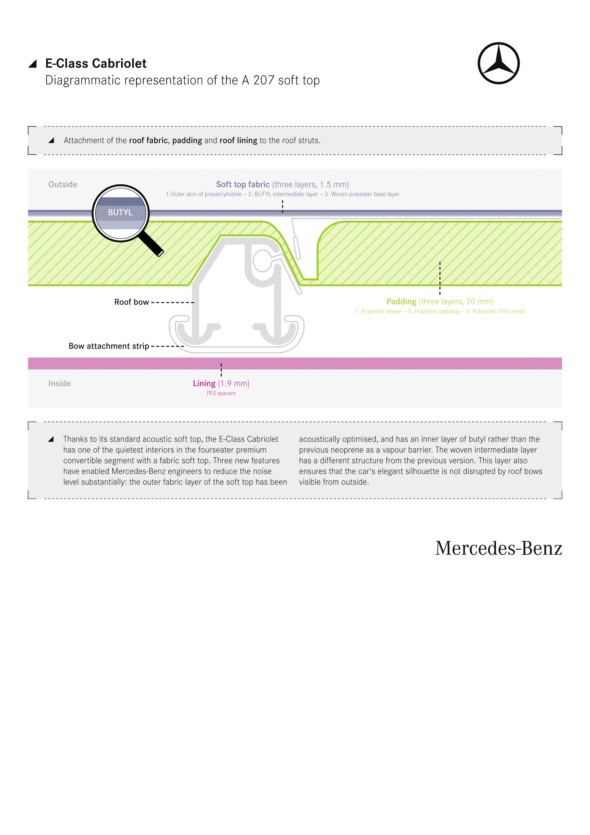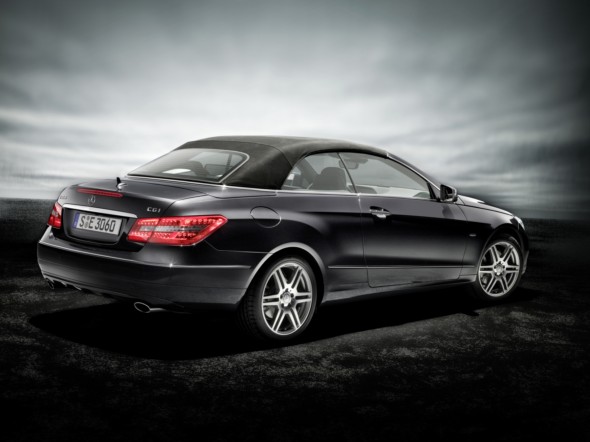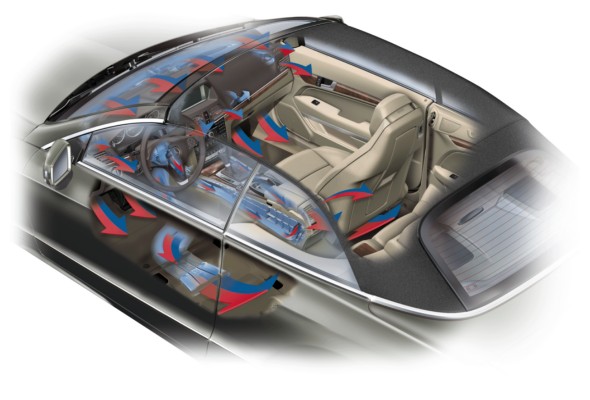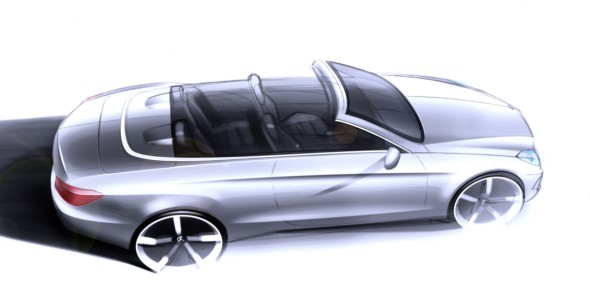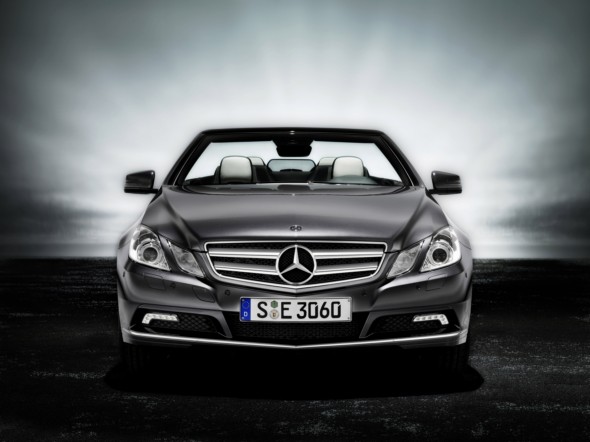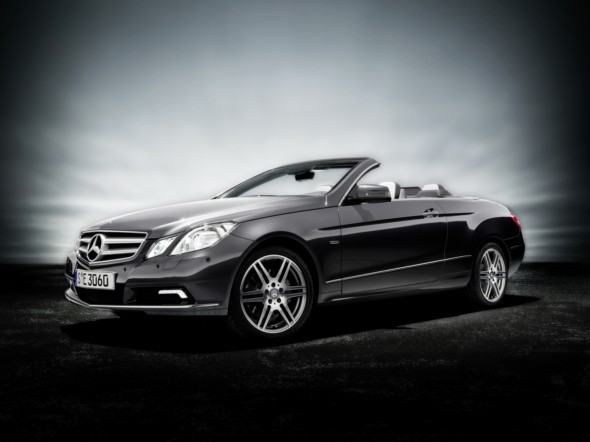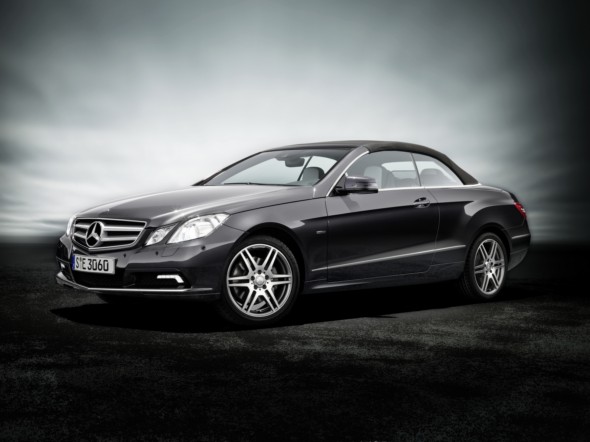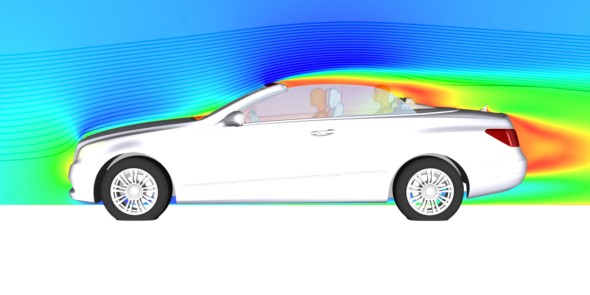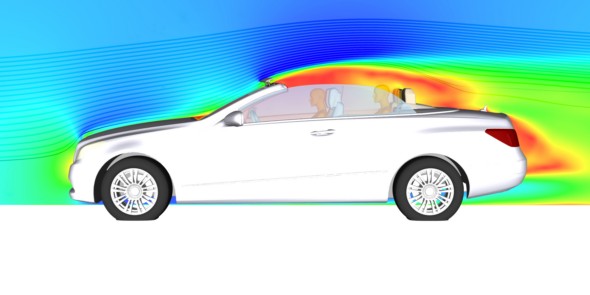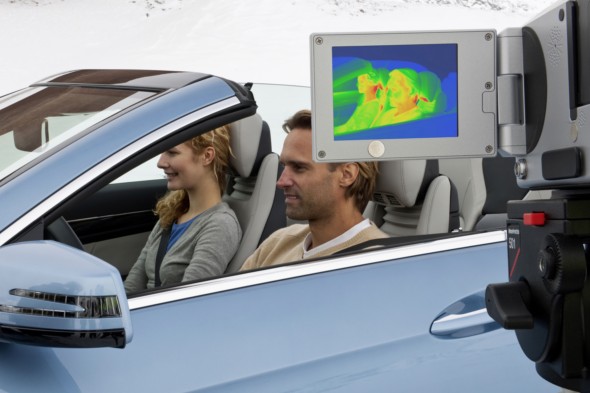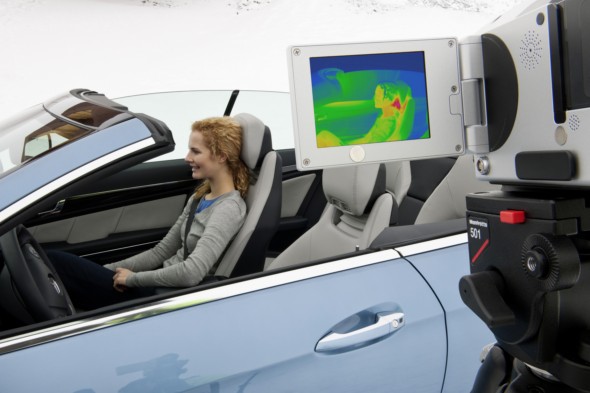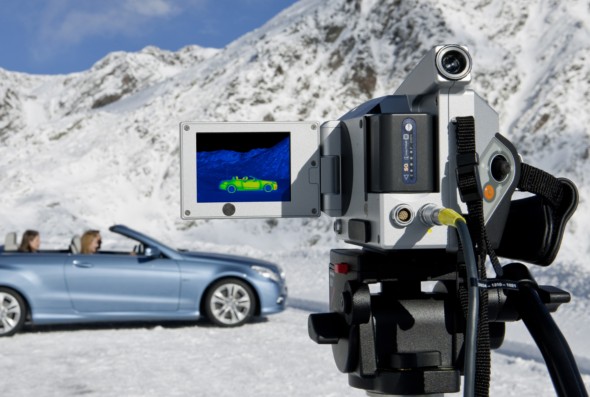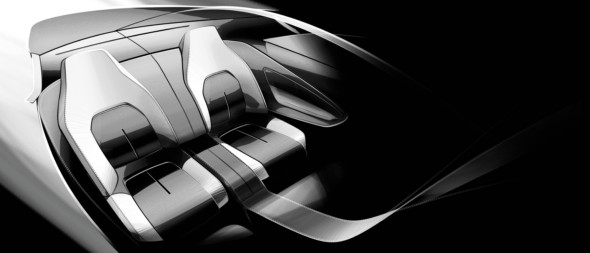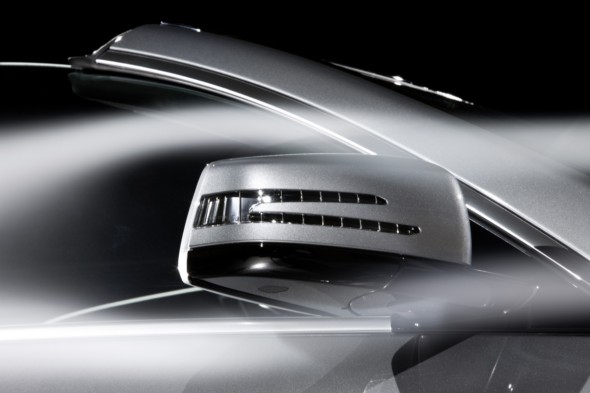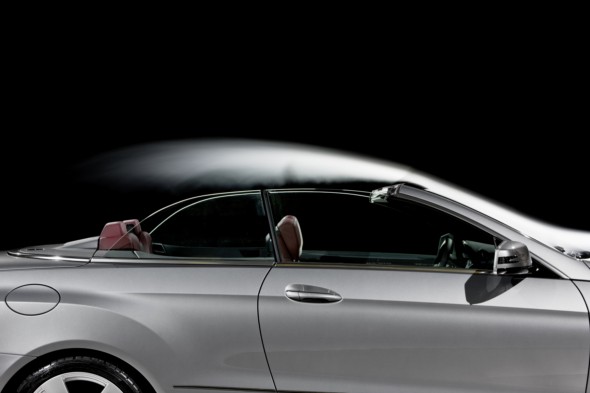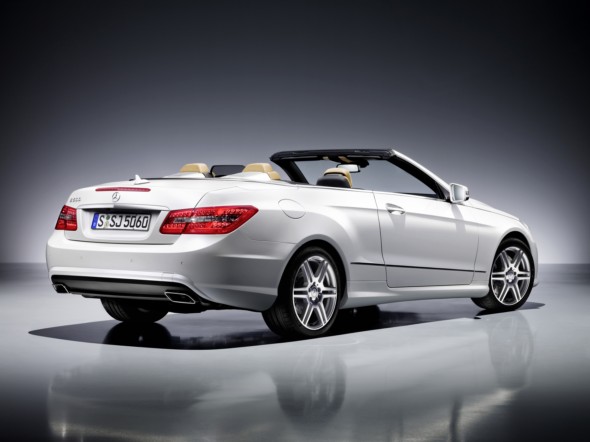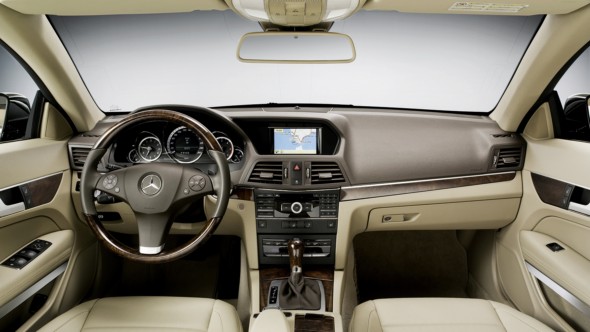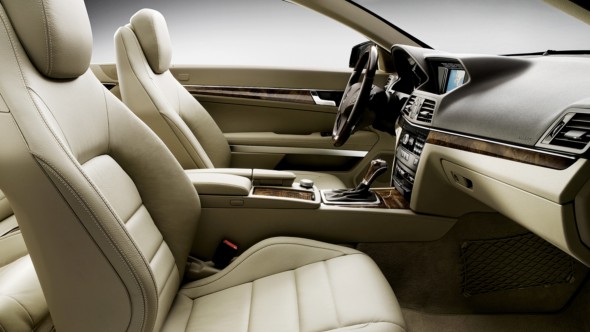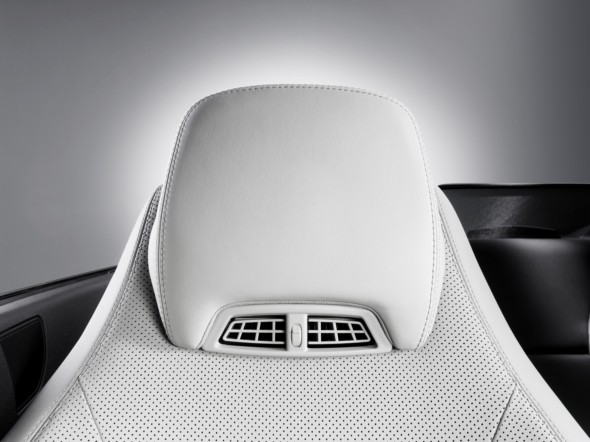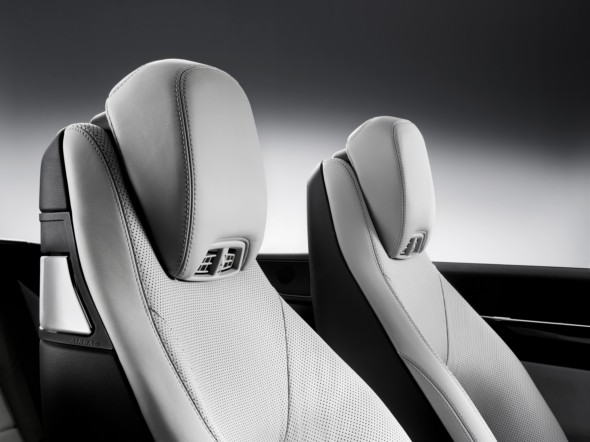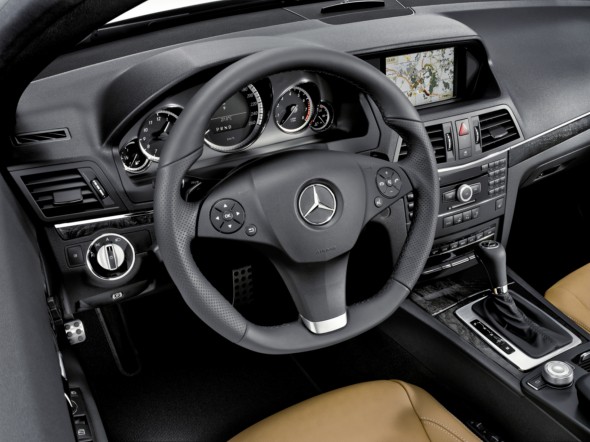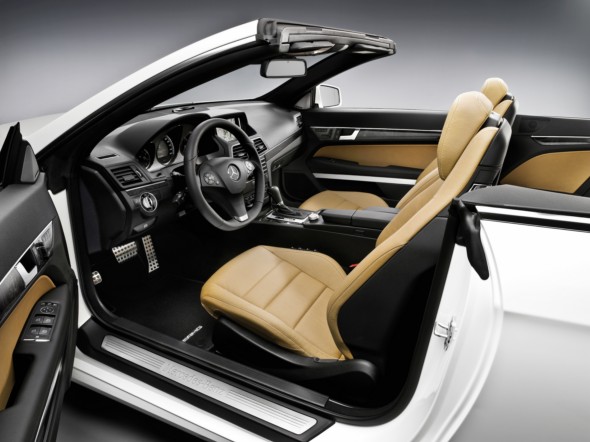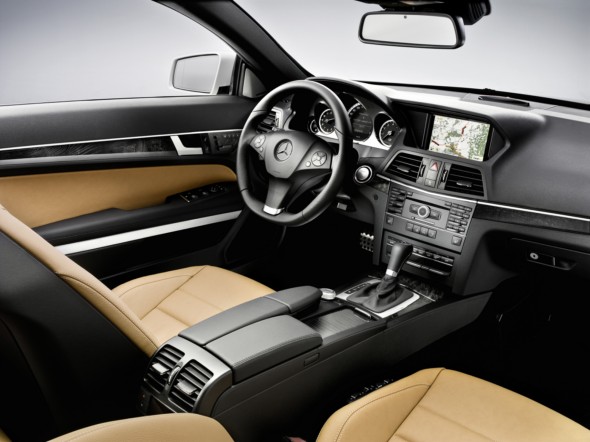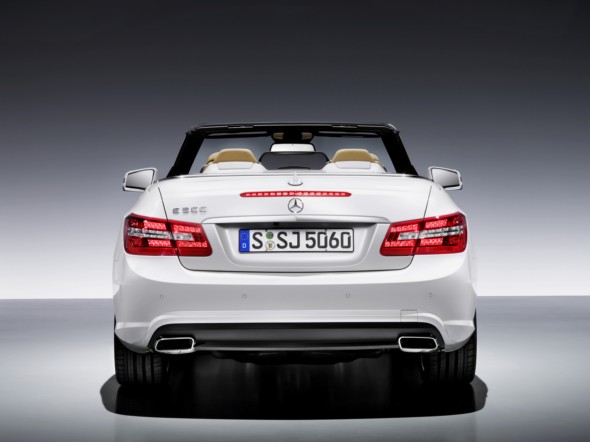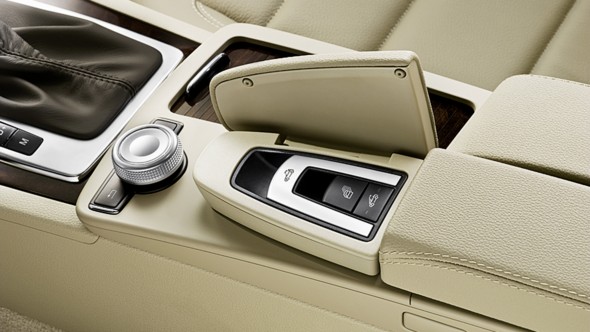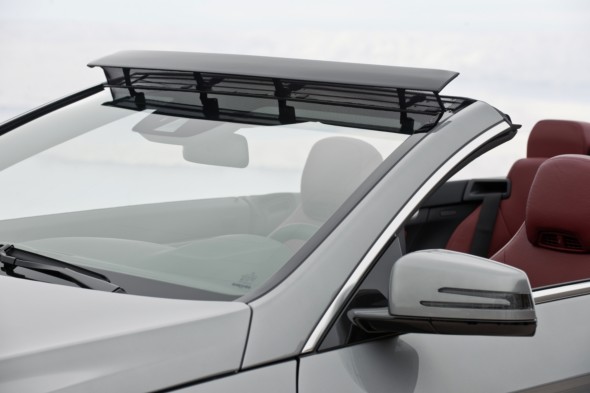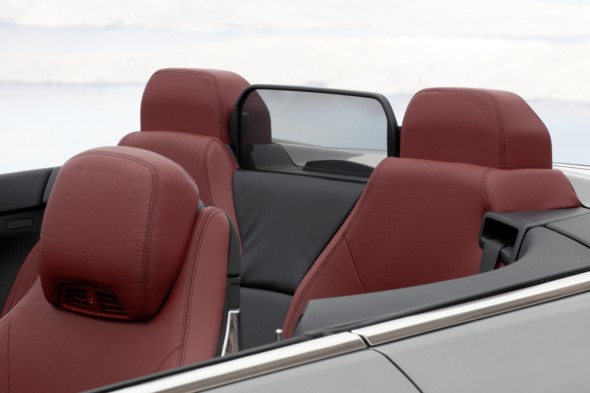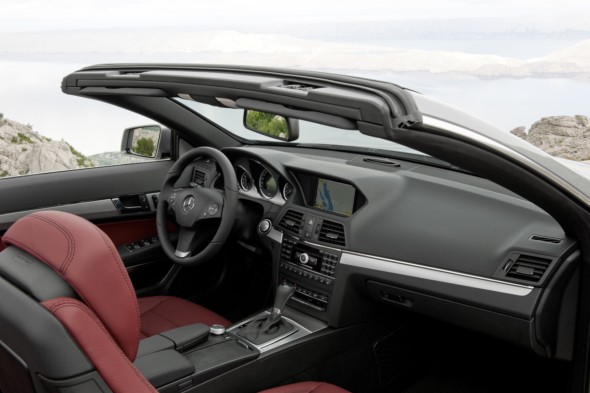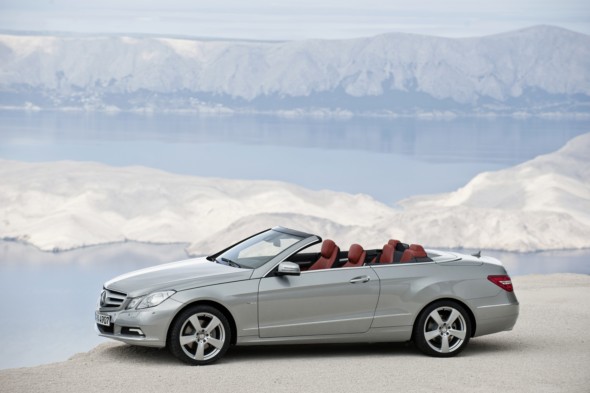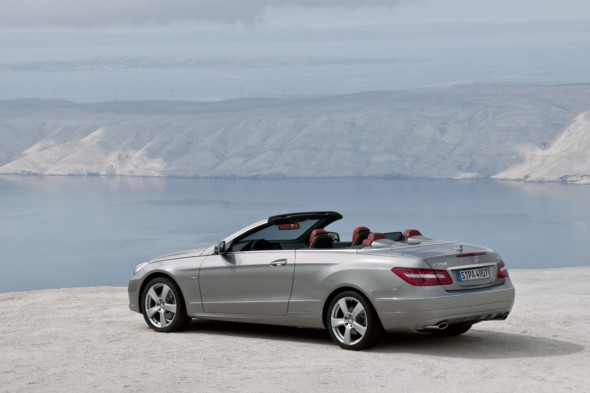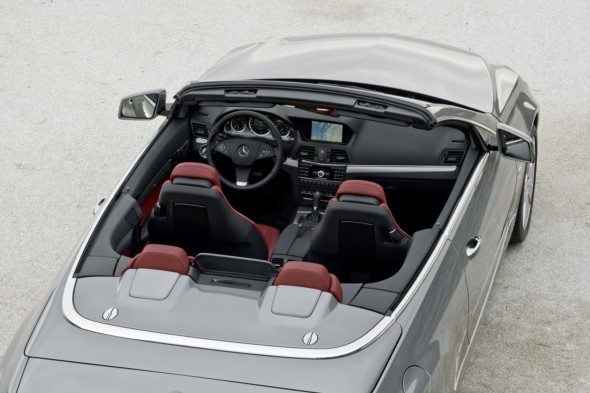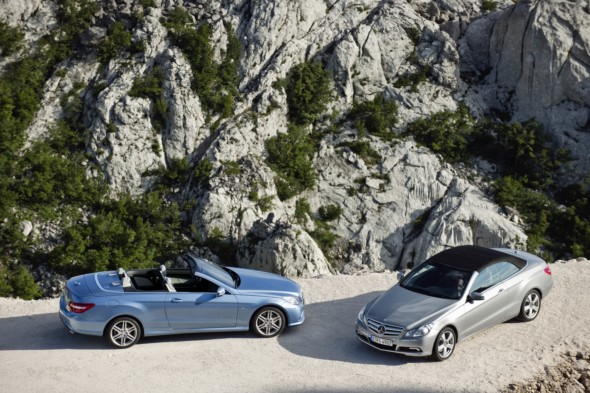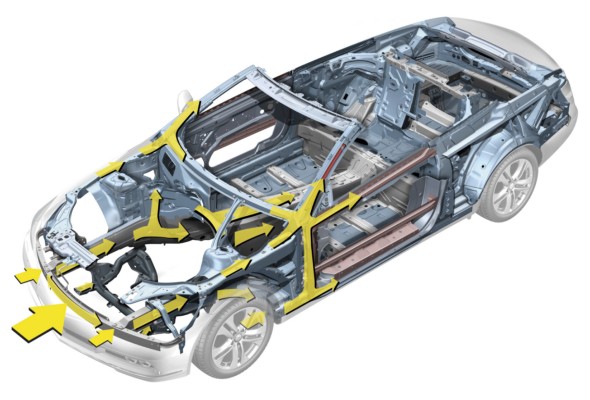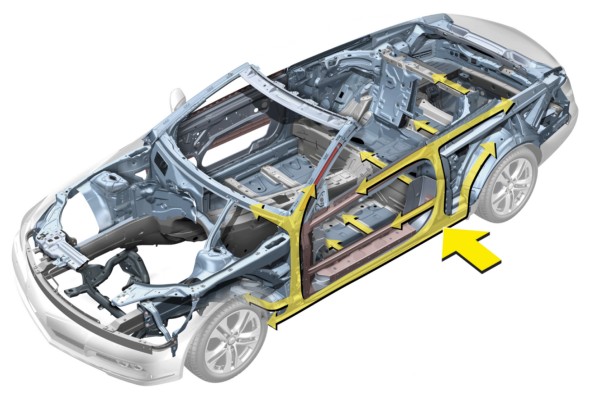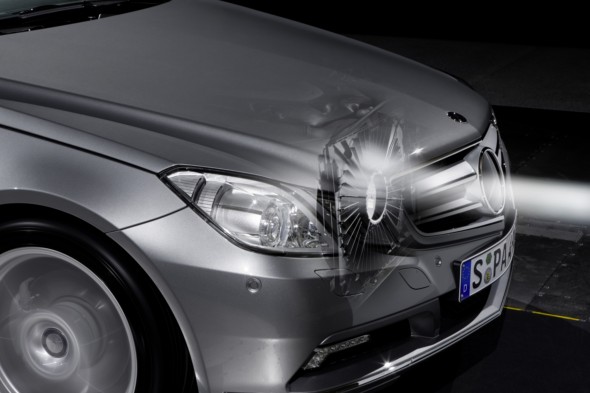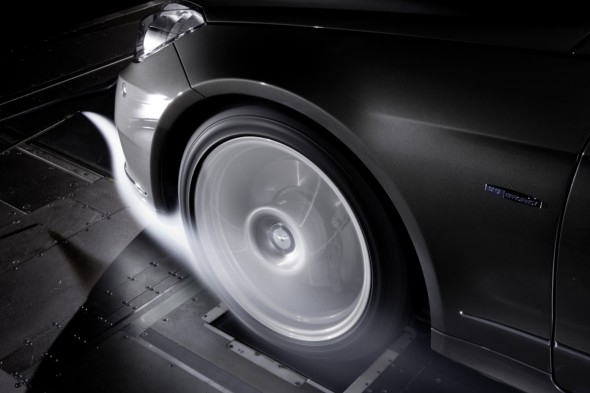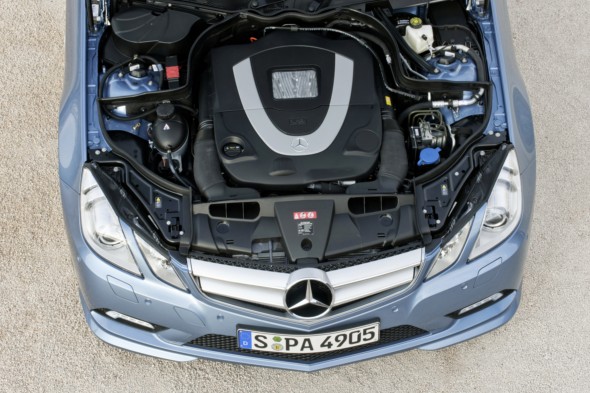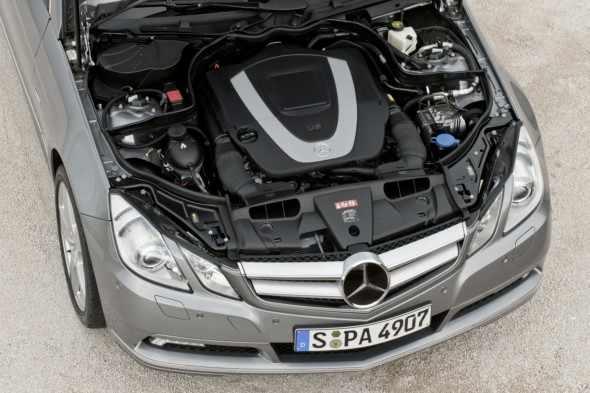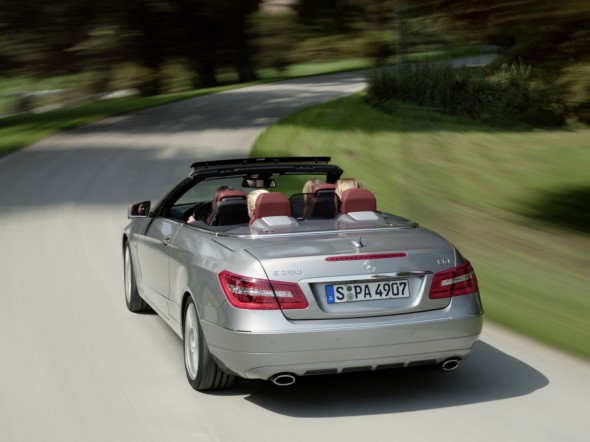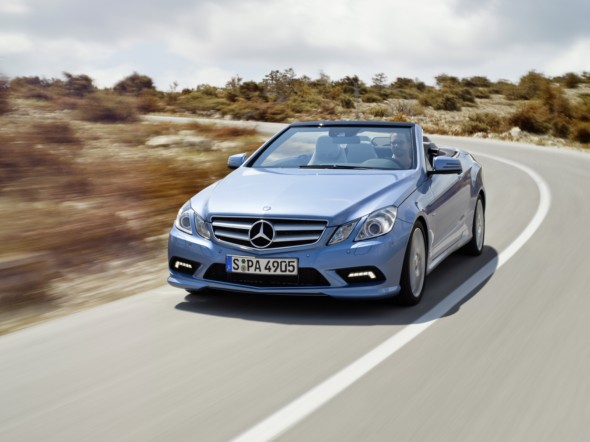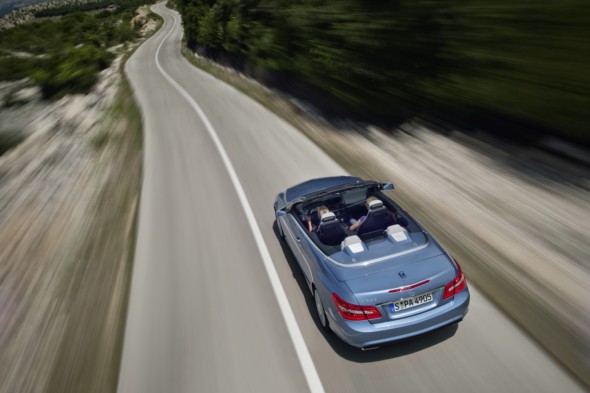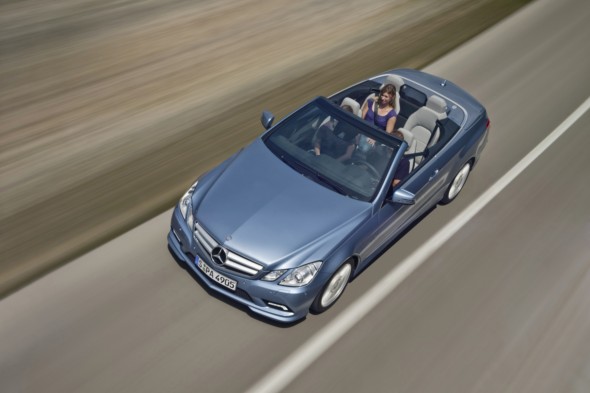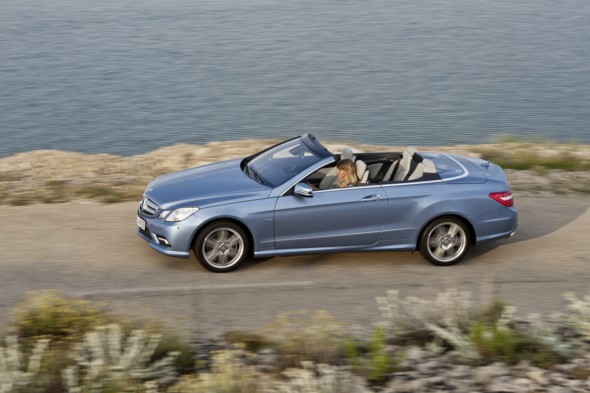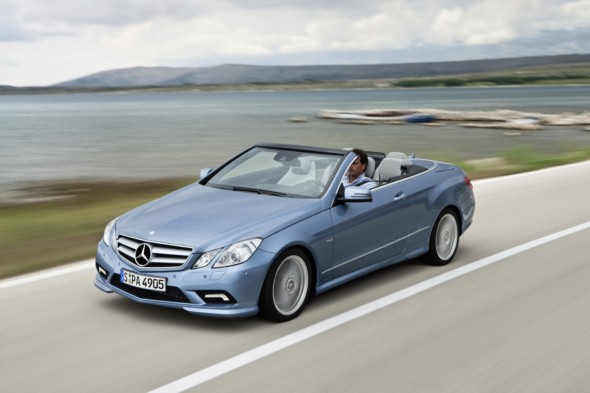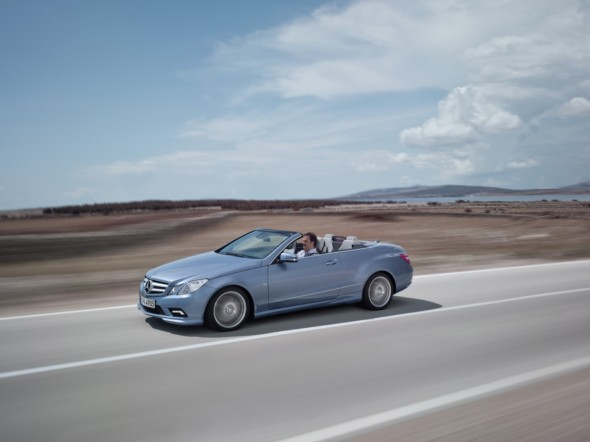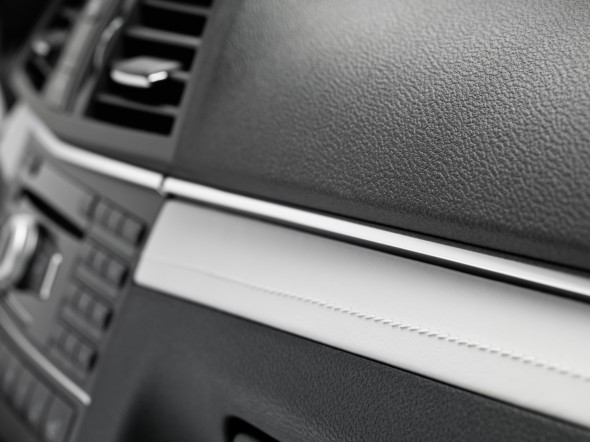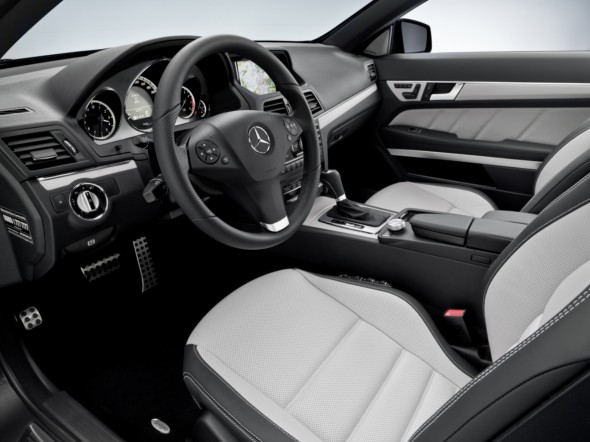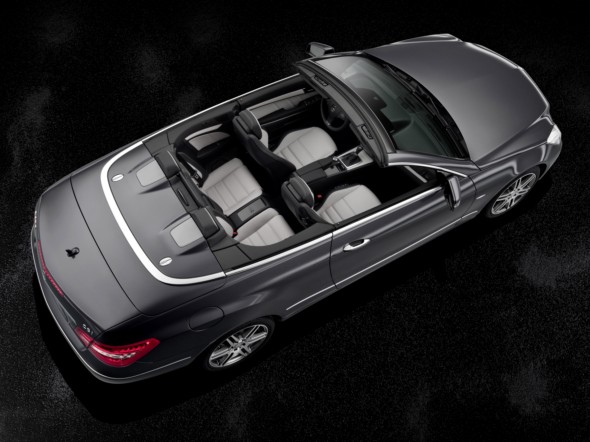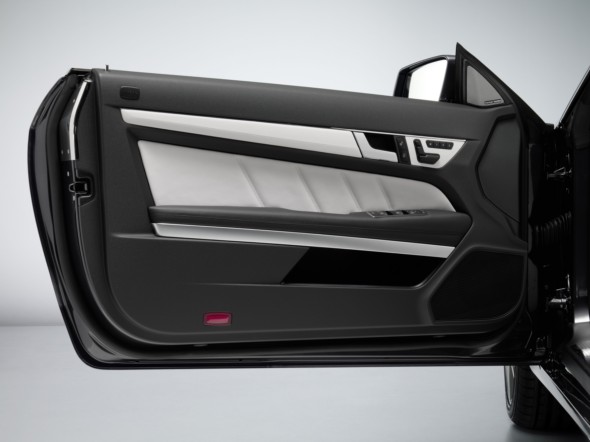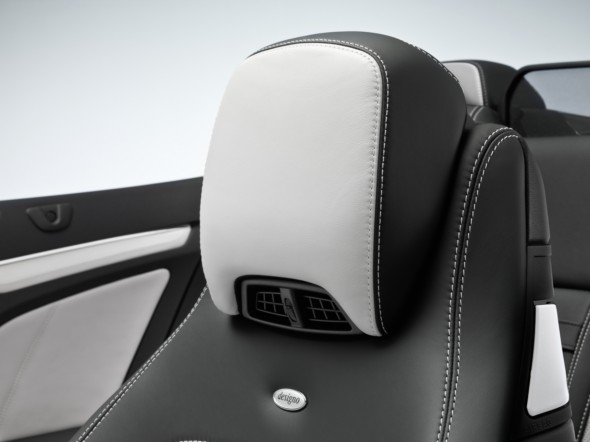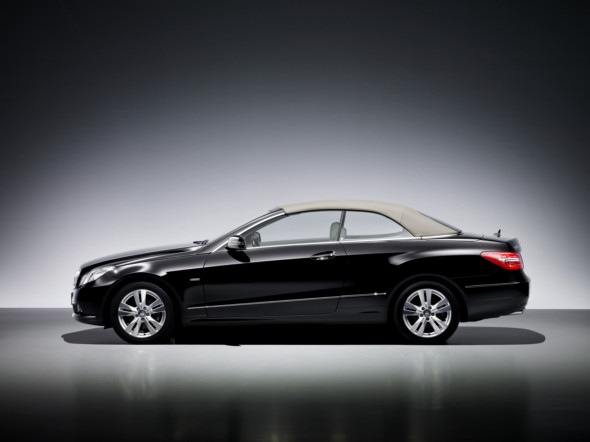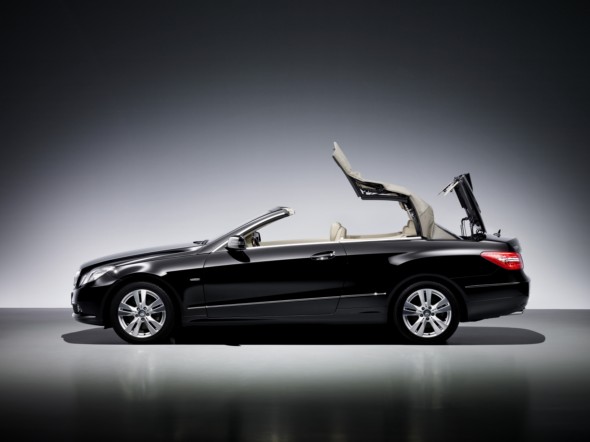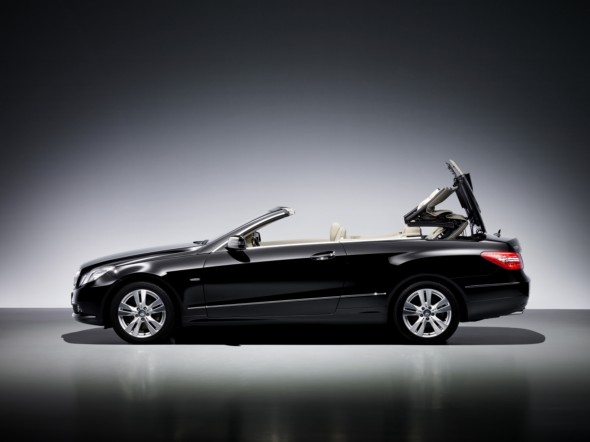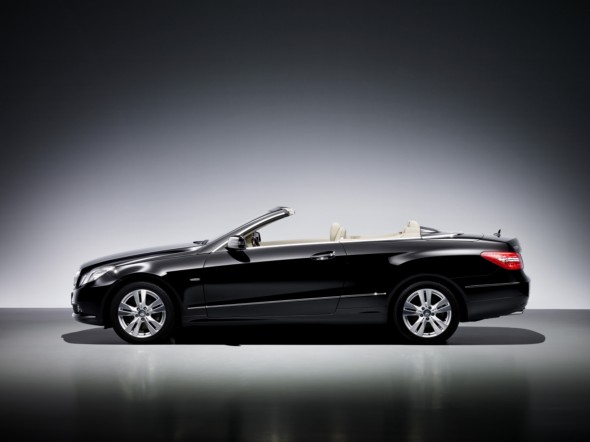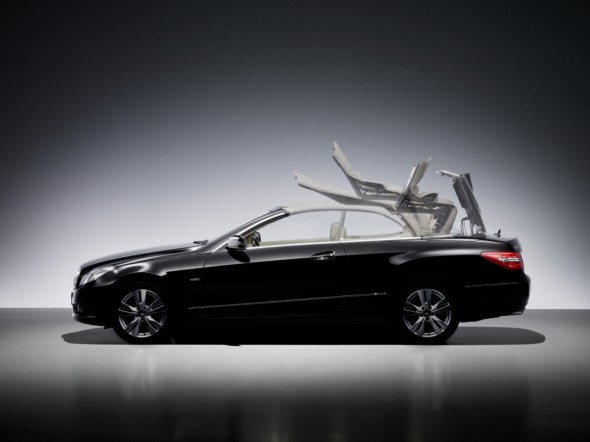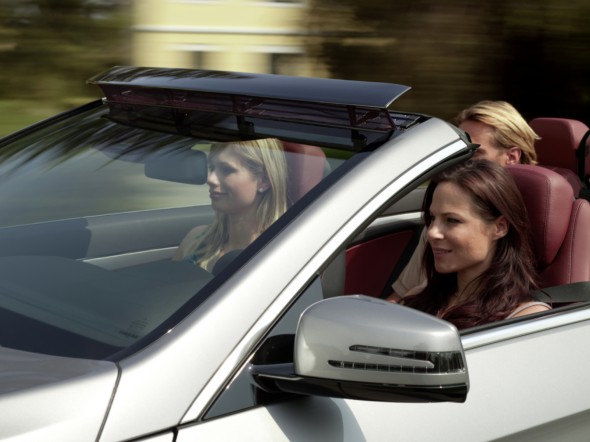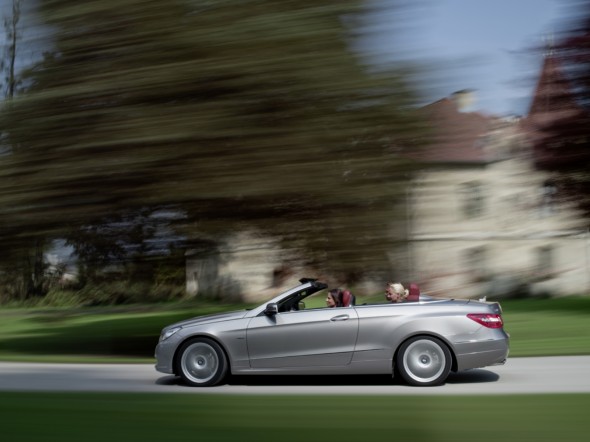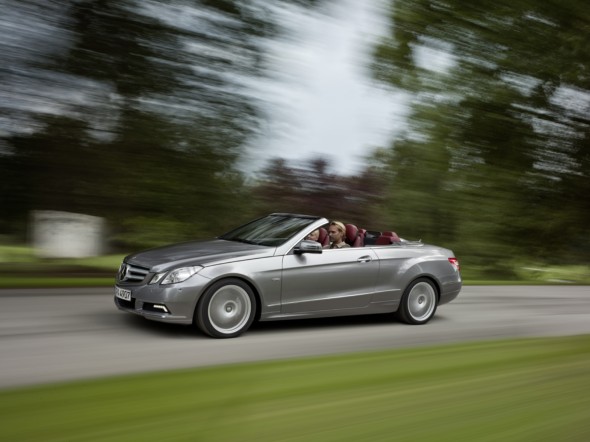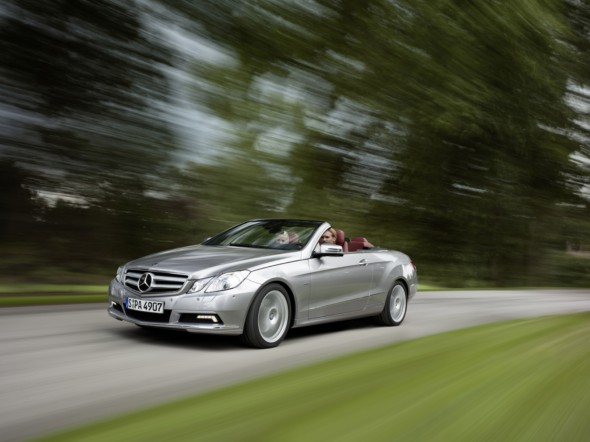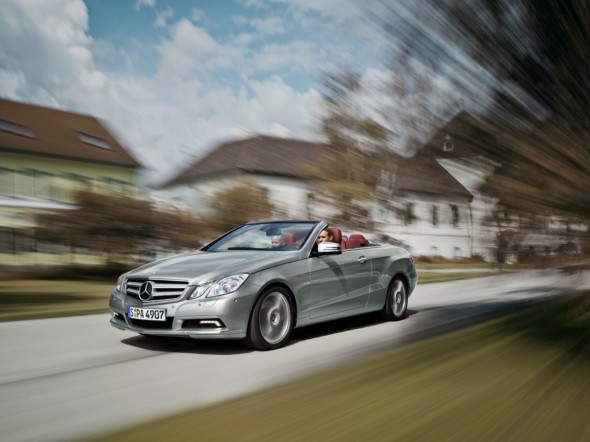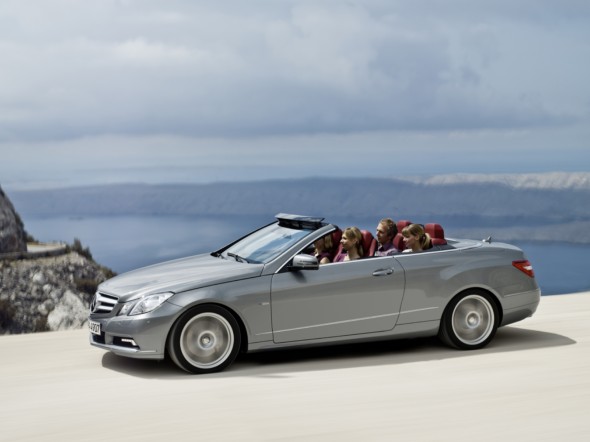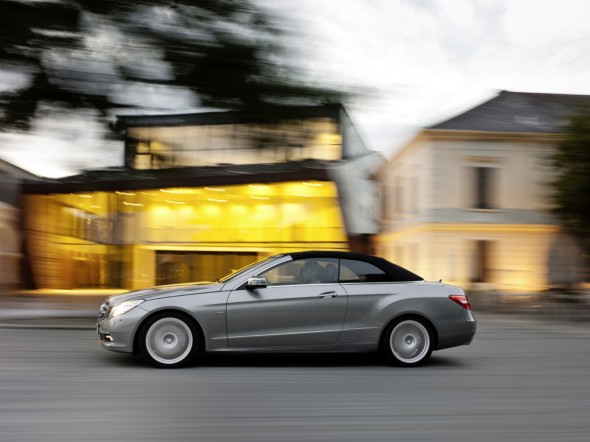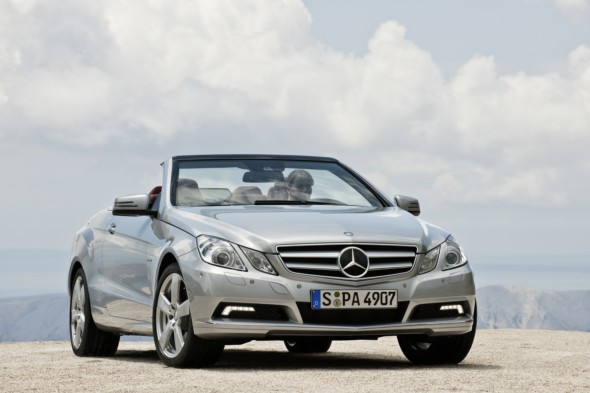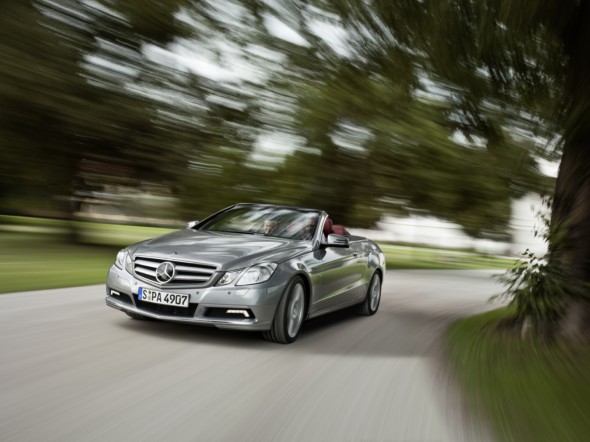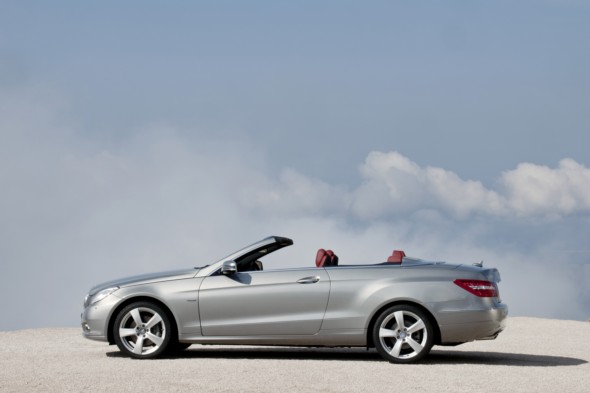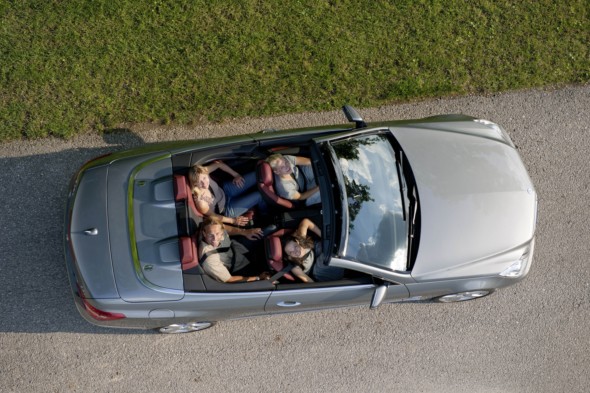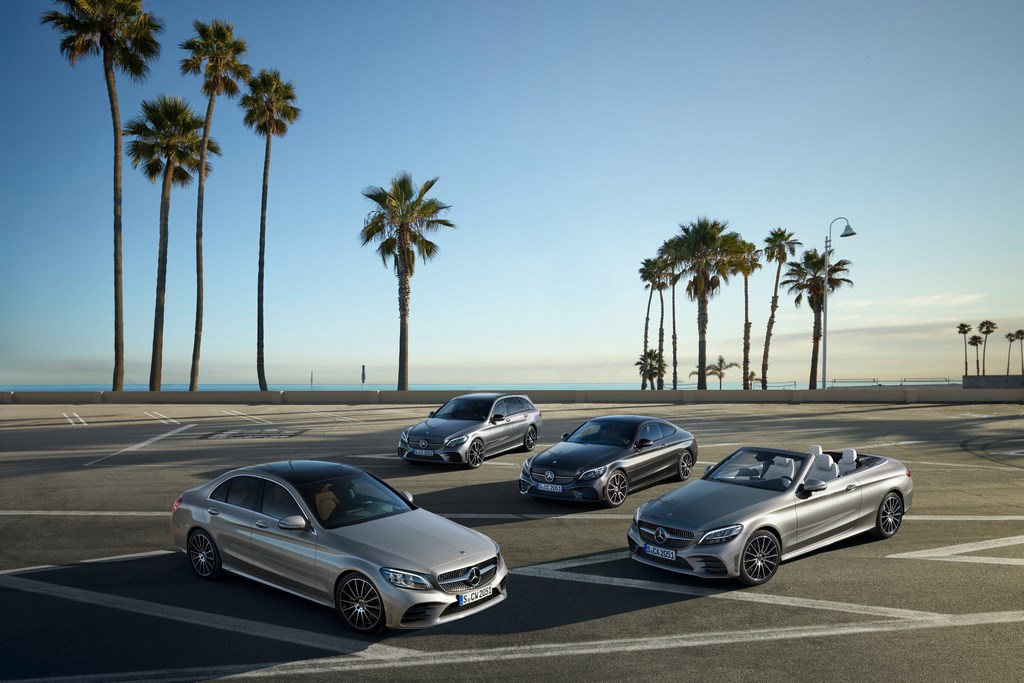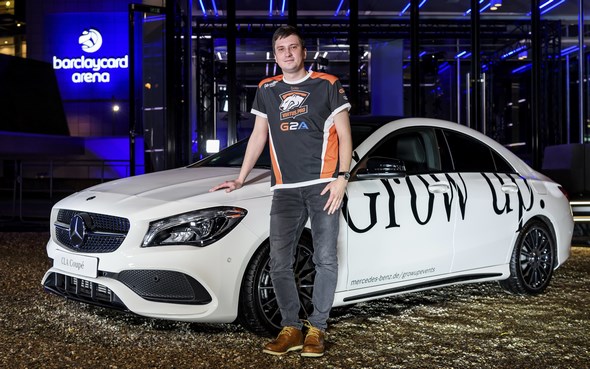Four seasons, four passengers

The new Mercedes-Benz E-Class Cabriolet
- Comfortable: AIRCAP® automatic draught-stop plus AIRSCARF®
- Quiet: acoustic soft top as standard
- Safe: robust roll-over protection and new headbags
The highly appealing and emotionally charged Cabriolet is the latest addition to the successful Mercedes-Benz E-Class line-up. The open-top two-door model, deliveries of which start from 27 March, features a classic fabric soft top, making for a stylistically pure cabriolet feeling. Viewed from the side, the new model is an intriguing proposition – with its clear proportions and a flawless cabriolet silhouette.
In keeping with the motto “four seasons, four passengers”, all-year-round suitability was right at the top of the developers’ list of priorities. With the new E-Class Cabriolet, the cabriolet season lasts the whole year because, while many cabriolets tend to disappear from the roads of Western Europe in the autumn, the Mercedes-Benz E-Class Cabriolet (length/breadth/height: 4698/1786/1402 mm) provides driving pleasure and comfort whether the roof is open or closed.
New features include:
- AIRCAP® automatic draught-stop: always on board and easily controllable at the push of a button, it reduces turbulence substantially for all four seat occupants
- Modified AIRSCARF® neck-level heating system
- Acoustic soft top fitted as standard
The soft top can be opened and closed fully automatically within 20 seconds – even when driving at speeds of up to 40 km/h. The cabriolet roof is stowed in a special compartment behind the rear panel. A retractable cover separates the soft top compartment from the boot area; this cover must be closed in order to close the soft top. If the roof is to remain closed, the cover can be slid rearwards, in which case the boot capacity is increased by 90 litres to 390 litres. A through-loading feature is included as standard for the new Cabriolet, as is EASY-ENTRY – a manually operated entry and exit aid for the rear passengers.
The powerplants for the new E-Class Cabriolet are equally innovative: the new direct-injection diesel and petrol models combine efficiency with effortlessly superior power delivery. The exemplary, low fuel consumption has not only been achieved because of the new engines, but also with a number of practical measures. These include on-demand activation of the steering and fuel pumps, the use of tyres with low rolling resistance, and an alternator control system which takes account of the current driving situation and the vehicle’s electrical power requirements, plus the crucial factor of outstanding aerodynamics. The Cabriolet’s cd figure of 0.28 is the best in its class, marking a continuation of the E-Class success story in the field of aerodynamics.
An overview of the engines:
- E 220 CDI BlueEFFICIENCY Cabriolet: 125 kW (170 hp)
- E 250 CDI BlueEFFICIENCY Cabriolet: 150 kW (204 hp)
- E 350 CDI BlueEFFICIENCY Cabriolet: 170 kW (231 hp)
- E 200 CGI BlueEFFICIENCY Cabriolet: 135 kW (184 hp)
- E 250 CGI BlueEFFICIENCY Cabriolet: 150 kW (204 hp)
- E 350 CGI BlueEFFICIENCY Cabriolet: 215 kW (292 hp)
- E 500 Cabriolet: 285 kW (388 hp)
The entry-level E 200 CGI model is fitted with an automatic transmission as standard. From June 2010, this model will also be available with a 6-speed manual transmission and the ECO start/stop function.
Less turbulence, easier to use: AIRCAP® is a world-first
In 1989, Mercedes-Benz introduced a world premiere in the shape of a draught-stop for the SL model series, followed in 2004 by the AIRSCARF® neck-level heating system to further enhance comfort in open-top models. Now comes another world-first: the AIRCAP® automatic draught-stop, which can be activated at the push of a button, greatly reduces turbulence in the interior of the new Mercedes E-Class Cabriolet, creating a sea of warm air. It is also much easier to implement and use than conventional draught-stops: there is no tricky installation, the two individual rear seats are easily accessible and the Cabriolet’s flowing side lines remain uninterrupted. AIRCAP® is therefore a classic Mercedes innovation: functional, comfort-enhancing, elegant and safe.
AIRCAP® consists of two components: a wind deflector that can be extended by around six centimetres with a net in the windscreen frame and a draught-stop between the rear seats.
The functions of the two components:
- Elevation of the free flow above the interior
- Net at the front reduces the annoying vacuum in the interior
- Draught-stop at the rear reduces the backflow
As well as enhancing occupant comfort and wellbeing, the reduction in draught when AIRCAP® is activated (it can be activated at speeds of up to 160 km/h and can remain in use right up to the car’s top speed) reduces the interior noise level – so passengers in all seats find it much easier to communicate.
The Cabriolet Comfort package includes AIRCAP® with AIRSCARF®. This patented system functions like an invisible scarf, which warms the occupants’ head and neck areas. AIRSCARF® is integrated into the backrests of the front seats and provides warm air through outlets in the head restraints.
The Mercedes engineers have modified this unique innovation specifically for the E-Class Cabriolet: in this model, an adjustment wheel pivots the outlet nozzle upwards and downwards by a total of 36 degrees over and above the head restraint height adjustment range, meaning that the driver and front passenger can enjoy the unique neck-level heating regardless of how short or tall they are.
Quiet, warm and windproof: acoustic soft top fitted as standard
Thanks to its acoustic soft top, fitted as standard, even the closed E-Class Cabriolet has one of the quietest interiors in the segment for four-seater premium cabriolets with a fabric roof. The soft top’s exceptionally high-quality insulation brings about a clearly noticeable reduction in the interior noise level compared to conventional fabric soft tops. Exterior noise caused by other vehicles and wind noise are therefore absorbed more effectively. On the road, the difference is audible from speeds of just 80 km/h, for example when driving through a tunnel or overtaking a convoy of trucks. At higher speeds, the benefits of the acoustic soft top are even more tangible. For instance, it is possible to have a perfectly normal phone conversation in hands-free mode even when travelling at a speed of over 200 km/h.
The soft top is of course waterproof and windproof. Plus it can be put through an automatic carwash without any hesitation. With a total thickness of 23.5 mm, the fabric soft top offers excellent thermal insulation, meaning that the E-Class Cabriolet is also ideal for use in winter.
Safety: robust structure, anticipatory protection and windowbags
The new Cabriolet offers the wealth of safety innovations one would expect from a Mercedes model. Highlights of the open-top two-door model include roll-over protection, the A-pillars reinforced by two additional tubes and the plug-in B-pillars. This new model is also the first Mercedes cabriolet to feature headbags. The roll-over protection consists of two robust bars, each with a diameter of 35 mm, which are housed in the rear head restraints in modules behind the rear seat backrests. If the sensors housed in the airbag control unit detect imminent danger to the occupants, pre-tensioned pressure springs are activated by pyrotechnic means,
i.e. extremely quickly.
Consequently, both roll-over bars in the rear head restraints are extended. They reach their highest point and are locked automatically within a fraction of a second. In combination with the robust A-pillars, each of which is reinforced with two high-strength steel tubes, the steel bars provide highly effective roll-over protection. The plug-in B-pillars are extremely robustly connected as they engage in the side skirts, thus offering highly effective protection in the event of a crash. A shoe made from ultra-high-strength steel braces the inside of the B-pillar against the rear seat crossmember.
With seven airbags fitted as standard, belt tensioners and belt force limiters for all seats, not to mention crash-responsive head restraints for the driver and front passenger, the new E-Class Cabriolet offers the most extensive safety equipment package in this vehicle category.
The airbags, which can deploy in milliseconds in the event of an accident, include front airbags and sidebags for the driver and front passenger, a kneebag on the driver’s side, and headbags. The latter, which appear in a Mercedes cabriolet for the first time, are housed in the door panelling in the beltline area.
Covering a wide area – around 0.7 x 0.5 metres with a volume of 17 litres when deployed – the airbags provide extremely effective protection for occupants large and small in the event of a crash. The side protection system – comprising headbag and thoraxbag – optimises the level of protection afforded to individual parts of the body. Rear sidebags are available as an option.
Further exemplary safety equipment available for the E-Class Cabriolet includes ATTENTION ASSIST drowsiness detection, PRE-SAFE® anticipatory occupant
protection, the sophisticated Intelligent Light System, the Active Bonnet and
DISTRONIC PLUS proximity control.
Positioning
A new experience every day
- Spellbinding cabriolet in the premium segment
- Emotional highlight of the E-Class family
Consummate refinement – the new E-Class Cabriolet renews and reinforces the high standards that Mercedes-Benz has always set for itself. Like its long line of predecessors, all of which are now sought-after collector’s items, the new luxury model represents one of the most elegant and luxurious ways to travel in style – be it for the daily commute to work, a spur-of-the-moment weekend away or a long holiday trip.
Unlike other premium manufacturers, Mercedes-Benz has always included one particular formula for success cherished by connoisseurs in its product portfolio: two doors, four seats and a classic soft top. Now Mercedes-Benz has perfected this formula by introducing exclusive innovations: the AIRCAP® automatic draught-stop and the further improved AIRSCARF® neck-level heating not only make open-top driving more comfortable, they make it enjoyable all year round. What’s more, the E-Class Cabriolet offers outstanding acoustic comfort regardless of whether the soft top is up or down. Then there are the familiar strengths of the
E-Class family: impressive suspension comfort and fleet-footed handling, exceptional active and passive safety, efficient and powerful engines, an extensive standard-equipment package and a vast array of optional extras for meeting even the most exclusive of requirements. “Our aim was the perfect cabriolet,” says product manager Gerd Junginger without any hint of false modesty. “In other words, not an everyday experience, but a new experience every day.”
The unique position of the Cabriolet within the E-Class family is also reflected in the profile of the typical buyers: they are younger and have higher incomes, as also highlighted by the increased take-up on options such as leather appointments, COMAND or top-of-the-line sound systems. The percentage of female buyers has increased, and many of the households own other cars as well.
“Typical E-Class Cabriolet buyers have their own businesses and, after a long day at work, like to reward themselves with a drive home in an open-top car,” says Junginger.
Market studies reveal the sheer joy associated with owning a beautiful car.
Prospective cabriolet buyers make the following statements more often than prospective saloon buyers: “A car gives me a feeling of freedom and independence”, “I like looking at beautiful cars” and “A car helps me to relax and leave everyday stress behind.”
Buyers in the USA and Europe in particular appreciate the ‘holiday feeling for four’ available every day: together, both regions account for over 90 percent of the buyers, although markets such as China and Russia are beginning to discover the joys of open-top driving, bringing the promise of growth in these regions, too.
Design
The stuff of which cabriolet dreams are made
- Classic: elegant cabriolet silhouette thanks to soft top
- Family ties: twin-headlamp face and muscular stature
- High quality: refined interior surfaces
From the very first drawings onwards, the Mercedes designers were sure of one thing: only a classic fabric soft top can convey a stylistically pure cabriolet feeling. Consequently, the new E-Class Cabriolet, which combines an elegant appearance with a high awareness of tradition, had to have a soft top. Viewed from the side, the two-door model therefore offers an enticing mix of clear proportions and a flawless cabriolet silhouette, including a long bonnet, wide doors, a high beltline with elongated side windows, a lowered soft top contour, and a short rear overhang. This look is complemented by the powerfully muscular section in the side wall at the rear axle and a slender C-pillar.
As well as sharing family traits with the other E-Class models, the new Cabriolet has its own, distinct identity characterised by a greater sense of passion. The arrow shape of the entire front section from front bumper to radiator grille to bonnet, the more extreme interpretation of the twin headlamp face and its more sinewy build give it a racier and more dynamic presence than the Saloon. At the same time, the close family ties with the E-Class Coupé are clearly apparent.
Powerful styling accentuates the sleek, flowing lines
A special characteristic of the contemporary Mercedes design idiom is the creative interplay of edges and surfaces. Taut, sharply defined lines, which grow out of surfaces organically and disappear into them again equally gently, structure the sides of the Cabriolet. The high shoulderline, a prominent, downward-pointing feature line (another contemporary Mercedes styling element) and a second structuring line delimit the sensitively sculpted surfaces. Alternately concave and convex, these create a sleek yet sharply defined flow of lines which creates a fascinating interplay of reflected incident light.
Arrow-shaped front and dominant radiator grille
From the front bumper to the radiator grille to the bonnet, the pronounced arrow shape of the front section emphasises the sporty character of the Cabriolet. A central crease in the bonnet picks up this shape and trails back towards the windscreen. A wide, upright radiator grille with two louvres, striking chrome strips, a powerful chrome surround and the central star testifies to status and self-assurance in time-honoured Mercedes style. The grille makes an effortlessly superior, expressive statement of the brand’s identity.
The traditional twin headlamp face is based on that of the new E-Class Saloon, but has its own distinct identity. Longer, more sharply inclined and flatter, the headlamps have a more dynamic look which is unmistakable. With their elaborate, high-tech interior and quadrant-shaped indicators, they add a sparkling finishing touch to the front of the car.
A distinctive front apron with large air intakes gives the vehicle a strong, powerful presence. Two vertical struts in the front apron provide visual support for the radiator grille and give it a substantial formal base. Depending on the model version, the bumper houses either the fog lamps or the daytime driving lights and fog lamps side by side. In the versions with bi-xenon headlamps, L-shaped daytime driving lights based on LED technology give the car an expressive look.
Powerful rear with innovative lights
“Powerful and not afraid to show it” could be the motto for the rear section of the new E-Class Cabriolet: the rear wings spanning the rear axle are sculpted to create a powerful, muscular form which visually enhances the car’s width. The distinctive feature line – a characteristic Mercedes styling element – is continued masterfully around the back of the vehicle and into the tail lights, thereby forming a link between front and rear.
The LED tail lights are split and extend from the boot lid far into the side wall. In so doing, they emphasise the width and dynamism of the vehicle. Their innovative lighting technology is particularly noteworthy. An LED background lighting system provides indirect illumination of the three-dimensional back cavity in both light units and in this way sets the basic background lighting tone. Twin light arrays with twin LED light guides stand out against the background lighting. These light arrays accommodate the tail lights and the brake lights, while the reversing lights and the LED‑fog lamp are integrated in the boot lid light clusters.
The narrowness of the gap between the light unit on the boot lid and that on the side wall, as well as the extremely precise bevelling of the adjacent light lenses allows light transmission between the two sections. As a result, the night design of the new Cabriolet maintains the perceived width and harmonious appearance of the rear section.
Interior with sporty lines and high perceived value
In the interior, the designers have continued the taut, sporty design idiom of the exterior. The compelling interplay of surfaces and clearly defined lines creates an interior whose elegance and high perceived value are evocative of modern architecture. The cockpit is structured horizontally with a dark upper section in order to avoid unwanted reflections. Interior appointments in two colours – in keeping with the logic of the two-level structure – create intriguing contrasts.
With its sporty look and feel, the cockpit design is clearly in keeping with the agile character of the new Cabriolet. The instrument cluster with five tubes for the dials and a central display has a slender look, while the dials themselves are clearly laid out and have high-quality chrome surrounds as well as a silver backing for the scales. The background colour of the dashboard is silver or black, depending on the choice of trim parts. The three-spoke steering wheel with multifunction buttons is available in a number of different versions and colours in order to match the interior appointments.
Next to the instrument cluster – and therefore in the primary field of vision of the driver and front passenger – is the display area for the control and display system for the radio, navigation system and other functions. The system is operated by means of a rotary and push-action Controller, which falls conveniently to hand in front of the asymmetrically split armrest between the front seats. This armrest also serves as a handrest when operating the Controller. Beneath this are the control buttons for the soft top and AIRCAP®. The horizontally divided dashboard merges into a dynamic, arrow-shaped centre console in which the air-conditioning controls, for example, are integrated.
Sporty individual seats for the rear passengers, too
The new E-Class Cabriolet is an out-and-out four-seater and also has sportily designed individual seats in the rear. The front integral seats with pronounced, faceted side bolsters and transverse piping on the seat cushion have a light, contemporary look and immediately create a distinctly sporty impression, while offering excellent seating comfort. Another notable characteristic of the seats is the high-quality, hand-stitched workmanship featuring discreet flat-felled seams. Further highlights include the audio system’s loudspeakers housed in the soft top compartment cover, which add an extra visual touch, especially when the roof is open.
Fine materials
The whole interior is dominated by pleasing surface finishes. Trim elements made from valuable, authentic materials emphasise the high-quality of the new Cabriolet. The sporty two-door model is equipped as standard with brushed aluminium trim parts with a sporty spin finish. Customers can also choose from fine woods: burr walnut, high-gloss black ash or the graphic linearity of pine. In all cases, the trim parts have a thin chrome strip along their upper edge.
The bodyshell
Solid basis reinforced at specific points
- Intelligent lightweight construction: 60 percent high-strength steel alloys
- Innovative joining techniques: robot-guided laser welding
A robust basis is the ideal ingredient for a stiff bodyshell offering a high level of crash safety. It plays a decisive role in ensuring maximum noise-related comfort, outstanding vibration characteristics and hallmark Mercedes-Benz longevity. In these terms, the E-Class Cabriolet had an ideal starting position, given that it is closely related to the E-Class Coupé – a two-door model which meets the very highest requirements when it comes to torsional stiffness and occupant protection.
The same applies to the Cabriolet, which has one of the stiffest designs in its segment. The body’s static torsional stiffness can be seen as a reliable indicator of the excellent cumulative effect of the implemented measures. It has been increased by around 30 percent compared to the outgoing model.
To achieve this figure, the bodyshell of the E-Class Cabriolet received extra reinforcements compared to its Coupé sister model, the most important of which are as follows:
- The extremely robust A-pillar assembly consists of two high-strength steel tubes which are welded to the sheet-metal shells of the A-pillars. In the case of the E-Class Cabriolet, both tubes have an exceptionally robust Y-shape and stretch from the A-pillar intersection to the upper window frame.
- The plug-in B-pillars are extremely robustly connected as they engage in the side skirts, thus offering highly effective protection in the event of a crash. A shoe made from ultra-high-strength steel braces the inside of the B-pillar against the rear seat crossmember. The rear support against the rear panel runs in an arch-like shape to the rear seats.
- Reinforced side skirts and bulkhead plates in the doors protect the occupants in a lateral impact with a pole, for example. Likewise the reinforced shoulderline with its high-strength steel section enhances
the exceptionally robust nature of the design. - The floor assembly has been reinforced solidly at several points.
- The robust rear panel behind the rear seats further enhances the body’s lateral rigidity.
Intelligent lightweight construction: state-of-the-art materials and innovative joining techniques
Despite the enhanced spaciousness, comfort and safety compared to the outgoing model, the weight of the bodyshell has been kept practically the same for the new E-Class Cabriolet thanks to intelligent lightweight construction. High-strength steel alloys account for around 60 percent of the weight. In the case of the side skirts alone, this high-strength, low-weight material reduces weight by some five kilograms.
The design and construction of the bodyshell are likewise weight-optimised. The energy-absorbing front crossmember, for instance, is inserted into the longitudinal members and no longer ends in flange plates. Tailored Blanks made from sheet steel are used in many places, such as on the underbody, where individual blanks of varying thickness and strength are joined by means of laser welding, or on the transmission tunnel, where the blanks optimise structural behaviour and crash performance.
In addition to these measures, the use of state-of-the-art structural adhesive plays a further important part in enhancing the body strength. The total length of the high-strength adhesive seams used in the bodyshell of the E-Class Cabriolet amounts to around 70 metres.
Mercedes-Benz employs innovative “RobScan” robot-guided laser welding for the E-Class Cabriolet. This new welding technology allows a very high welding speed with optimum weld quality. The technology is used in the rear centre section of the Cabriolet – with a total of 26 welds.
Quality right from the start: visual inspection and NVH optimisation
Alongside the usual quality assurance measures, all joining techniques are subject to process monitoring, which ensures quality in each individual stage of production. The MIG (metal inert gas) solder seams, for instance, are monitored by means of a 3D light-strip sensor. The position, width and completeness of the adhesive seams are checked by an integrated camera when the adhesive is applied. The spot welds likewise undergo a visual inspection: the photos taken by a thermography camera confirm whether the spot welds have the correct diameter.
A further important aspect of quality is a car’s NVH behaviour (noise, vibration, harshness). Here, too, the bodyshell plays a key role. Sturdy transverse sections in the floor assembly – known as transmission tunnel braces – along with optimised lower seat crossmember sections and reinforced engine mounts are just some of the NVH measures implemented to improve vibration characteristics.
Easy to repair: reversible bonnet
Development of the E-Class body focussed on customer benefit at all times, as shown by the Active Bonnet, which reduces the risk of injury to pedestrians and features a reversible design.
Further easy-to-repair and, therefore, money-saving solutions include the bolted-on crash boxes at the front and rear as well as the radiator fastening
Aerodynamics
Only the aerodynamicist knows the answer
- Efficient: the more streamlined the design, the lower the fuel consumption
- Quiet: low air swirl means low noise
- Exemplary: the E-Class of 1984 – and today’s model
In 1984, the E-Class (model series W124) achieved an aerodynamic landmark, posting a cd figure of 0.29. It became, and remains, the benchmark against which all saloons have to be measured – a benchmark that very few manage to match. Design elements such as smooth surfaces, an inwards-drawn rear end and a clear spoiler lip on the boot lid remain at the heart of good aerodynamic design to this day.
Since then, Mercedes has been working tirelessly to reduce this figure by yet more crucial hundredths. After all, lowering the cd figure by 0.01 is equivalent to a reduction of one gram of CO2 per kilometre (NEDC), or two grams in the case of average real consumption, and as many as five grams of CO2 per kilometre at 150 km/h.
The new E-Class family is the new benchmark in the automotive world. Although the base tyres are becoming increasingly wide – not necessarily to the delight of the aerodynamicists – and the wheels are becoming increasingly large, the Saloon version is one of the world’s most streamlined four-door models, with a cd figure of 0.25. And the Coupé model’s cd figure of 0.24 is a new record for production cars.
The detailed work behind this development is highlighted by the following examples:
- The louvres of the cooling air control system behind the radiator are mainly closed when there is no particular demand for cool air, thus reducing pressure losses at the front of the vehicle and air swirl on the underbody. Here the payoff is an improvement in aerodynamic drag to the tune of five percent or a reduction in the cd figure of 0.01
- Small spoiler lips on the tail lights homogenise the airflow at the rear. The airflow breaks away at a clearly defined point. There is therefore a uniform spoiler lip across the entire rear end
- The contours of the spokes and the rim flanges have been optimised to ensure levels that were only previously achievable by using smooth-surfaced hub caps
- The underbody panelling has been optimised, while the spare wheel well is designed as a diffuser
- In isolation, tweaking the shape of the spoilers in front of the wheels, the rubber sealing sections or the underbody panelling only brings about a minimal improvement in each case; however, when combined, these
measures contribute to the world-leading cd figure
The new E-Class Cabriolet also benefits from all of these measures. Naturally, the fabric soft top cannot quite match the closed sheet-metal design of the Coupé. But the fabric and the contours of the folding top have been optimised to such an extent (see the section entitled “The roof” in this press kit) that the Cabriolet likewise achieves the best aerodynamic performance in its segment with a cd figure of 0.28.
Calmness itself: acoustic optimisation right from the start
Wind noise is another discipline of aerodynamics. Key requirements for a low wind noise level in the interior include draughtproof door and window seals. This requirement especially applies to cars with frameless side windows such as the new E-Class Coupé and Cabriolet.
Measuring tools such as dummy heads and directional microphones enable even the slightest weakspots to be pinpointed. These can then be eliminated by implementing the best possible technical solutions. At a very early stage in the development of the new, sporty E-Class model, a three-metre concave acoustic mirror was used to optimise the exterior shape of the A-pillars and the shape of the exterior mirrors in the wind tunnel.
The Cabriolet model marks the debut of a new acoustic soft top, which is fitted as standard, meaning that the E-Class interior has one of the lowest noise levels in the segment for four-seater premium cabriolets with a fabric soft top. It is therefore possible to have a perfectly normal phone conversation in hands-free mode at speeds of over 200 km/h. Further details can be found in the section entitled “The roof” in this press kit.
A further innovation is likewise designed to enhance comfort: now the front seat belt straps no longer run horizontally but, instead, are turned 35 degrees towards the occupants’ shoulders. The advantage of this modification is that the wind pressure on the outside of the belt strap prevents annoying belt flapping when driving with the roof down. This “shoulder-knocking” effect has been reduced substantially at speeds of up to 120 km/h.
Under the microscope: aerodynamics
Technology for efficiency
Resistance that does not have to be overcome requires no power and, therefore, does not cause fuel consumption. As motor vehicles increase their speed, wind resistance above all becomes a factor, as it increases at the square of the vehicle speed: at a speed of around 80 km/h, it becomes greater than the sum of all other driving resistance, making it the key variable when determining the overall resistance. But even at lower speeds, the 1.2 kg or so of air per cubic metre that the car has to get through must not be neglected: in a modern car, assuming a typical customer driving cycle, around two litres of fuel per 100 kilometres are required just to overcome the wind resistance.
Wind resistance is determined by the vehicle speed, the air density and two further factors: the frontal area of the vehicle and the drag coefficient (cd figure). Whereas there is a significant difference between the frontal area of a roadster and that of a SUV, for instance, the difference between two vehicles in the same segment is far less pronounced: comfort and safety requirements determine the dimensions of the car, especially its height and width. Mounted components such as the exterior mirrors cannot simply be reduced to any size, since statutory requirements have to be met here.
Hence the main focus when developing a vehicle is to split the air ahead of the vehicle so that the flow is as unrestricted as possible and then bring the air together again as smoothly as possible behind the vehicle. The cd figure indicates how successfully this is achieved. But here, too, practice has shown that there are limits.
Fully closed wheel covers, for example, are neither visually appealing nor beneficial for brake cooling. The aerodynamically ideal droplet shape with a long and tapered rear end, for instance, can be discounted immediately because of the length of parking spaces and garages, not to mention dimensional concept requirements such as the rear seat width, sufficient boot width and boot loadability. What’s more, the air has to be channelled around the vehicle so that the side windows do not become dirty and hamper the driver’s view of the exterior mirrors.
A cooling air control system ensures that air flows through the radiator to provide the required degree of cooling here. Another important criterion in aerodynamic development work is driving stability, which is influenced by the front and rear axle lift.
AIRCAP® – an innovative idea
Less draught at the push of a button
- Practical: AIRCAP® reduces in-car turbulence at the push of a button
- Comfortable: sea of warm air washes around passengers, even at high speed
- Refined: combination of wind deflector and adjustable draught-stop
Whether you want to feel the wind in your hair or not is entirely up to you: the new Mercedes-Benz E-Class Cabriolet is the first car that can fulfil either of these wishes at the push of the button. The innovation behind this is called AIRCAP® – an automatic draught-stop system that reduces interior turbulence at all four seats whilst setting new standards in terms of ease-of-use and acoustic comfort.
At the same time, this innovation enables the Mercedes-Benz E-Class Cabriolet to be driven with the top down in all four seasons – even with a full complement of occupants on board. When paired with the further improved Mercedes innovation AIRSCARF®, it makes open-top driving a highly pleasurable fresh-air experience, even when it is cold outside. Because a ‘cap and scarf’ are always on board.
AIRCAP® consists of two components: a wind deflector that can be extended by around six centimetres with a net in the windscreen frame and a draught-stop between the rear seats. AIRCAP® therefore meets two aerodynamic requirements: the wind deflector elevates the airflow, while the net raises the pressure level in the interior in a controlled manner, thus reducing the backflow, which is curbed and equalised by the draught-stop. Hence the air movements in the interior of the E-Class Cabriolet are reduced substantially, creating a sea of warm air: warm air flowing into the interior from the heating system remains there for much longer when AIRCAP® is activated. Similarly, on extremely hot days, the air conditioning and AIRCAP® allow the passengers to enjoy a pleasantly cool interior, even when the roof is open.
Practical and comfortable: a new dimension of open-top driving
AIRCAP® offers a wealth of benefits over conventional bracketed draught-stops:
- At the push of a button, AIRCAP® reduces turbulence, even for those sat in the rear seats
- No manual installation or removal required
- Rear seats always remain fully accessible – either for passengers or for luggage items such as sports bags or briefcases
- No need to stow the draught-stop in the boot when it is not in use, which would take up valuable space
- Vastly improved all-round visibility
During a product clinic organised by the Mercedes Market Research department, cabriolet drivers were able to test the new system on prototypes – and they welcomed it enthusiastically. Not least because the central control panel can be used to operate the AIRCAP® functions and, at the push of a button, lower all four side windows simultaneously. Furthermore, the driver can activate the AIRCAP® system at speeds of up to 160 km/h, while the system can remain in use right up to the car’s top speed.
The front element of the AIRCAP® system – the wind deflector with perfused net in the windscreen frame – is switched to either on or off. Meanwhile, the small draught-stop between the rear head restraints, together with which it is moved up and down electrically, has three positions: retracted, half extended and fully extended. In the lower position, AIRCAP® is deactivated. When the AIRCAP® button is pressed, the system adopts the middle position, in which case the front occupants enjoy the full benefit of less driving wind, while rear visibility is not impaired. If one of the rear occupants puts on a seat belt (i.e. if at least one of the rear seats is occupied), the head restraint and draught-stop move to their highest positions, meaning that even the rear passengers enjoy better protection from the wind than passengers in conventional cabriolets. Finally, the wind deflector
module can also be extended when the roof is up, for cleaning purposes, thanks to a special switching system.
When AIRCAP® is activated, not only is there less draught, meaning increased comfort, the interior noise level is also reduced substantially – all passengers therefore find it much easier to communicate with each other.
How it works: a triumph of aerodynamics and design
Many years of intensive development work were required before AIRCAP® was ready for series production. When the team of aerodynamics experts headed by Peter Dannhäuser and Dr Alexander Wäschle started developing the automatic draught-stop for the E-Class Cabriolet, they seized an idea that had already been tested for the E-Class Cabriolet (model series 124) at the beginning of the 1990s but could not be implemented (see section entitled “Under the microscope – from KOF4 to AIRCAP®“).
The function of the two components soon became clear:
- Elevation of the free flow above the interior
- Net at the front reduces the annoying vacuum in the interior
- Draught-stop at the rear reduces the backflow
- Faint secondary swirl in the lower area of the passenger compartment
However, many simulations (see section entitled “Under the microscope: flow simulation”) and numerous wind tunnel tests were required to optimise the exact dimensions and positions of the two AIRCAP® elements. Selecting suitable nets proved especially time-consuming: over two hundred different combinations were tested until the optimum material mix was found in terms of through-flow, dirt deflection and durability.
Implementing the idea in series production then provided a further major hurdle for the team around Bernd Plocher together with the designers Daniel Seifert and Serkan Fidan. The invention of a new four-link kinematic system allowed them to integrate the extendable wind deflector into the smallest of spaces in the upper windscreen frame without altering the latter’s contours and, therefore, the car’s flowing lines. The intelligent construction and the selection of high-strength lightweight materials enabled them to produce an extremely slender wind deflector. It proved particularly tricky to house the electric drive system in a cavity measuring just three centimetres across – but a specially contracted Swiss supplier eventually came up with a suitable drive motor with a diameter of 1.8 centimetres and a torque of six newton metres.
The wind deflector also had to be designed to withstand the heavy pounding by the wind and weather without letting moisture or dust reach the car’s interior or the sensitive drive components – all of which was verified in extensive tests (see section entitled “Testing” in this press kit). Finally, the protective effect of the windscreen frame had to remain fully intact in the event of roll-over. This was achieved thanks to the integral design of the front wind deflector module with the kinematic elements.
The wind deflector module is also an integral part of the PRE-SAFE® functions for the E-Class Cabriolet.‑If an imminent accident is detected, AIRCAP® retracts into the windscreen frame.
The wind deflector module comprises a total of 211 individual components (motor/gear unit counted as one component), while the 32 different materials used are protected against all environmental influences by 14 different coatings and surfaces. One further number clearly underlines the lengths to which the developers went to enhance comfort for cabriolet drivers: the development is protected by almost 20 patents.
AIRCAP® is a world-first which sees Mercedes-Benz continuing its tradition of using innovations to make open-top driving exceptionally comfortable and safe. It was in 1989 that the brand introduced the first draught-stop as a world premiere in the SL model series – a feature that has now long been standard in roadsters and cabriolets made by many other brands. Here are some of Mercedes-Benz’s other pioneering achievements:
| Mercedes innovations have been making open-top driving safer and more comfortable for over 45 years
| |
| 1963 | Standard equipment for the 230 SL (W 113) included a removable coupé roof. The two-seater’s nickname “Pagoda” was derived from the roof’s classic shape. The removable coupé roof remained a regular feature of Mercedes sports cars up until the launch of the SL with vario-roof (R 230, 2001). |
| 1989 | The automatic roll-over bar and the draught-stop for the Mercedes SL (R 129) were world-firsts in the automotive industry. |
| 1996 | With the first-generation SLK (R 170), Mercedes-Benz revolutionised the idea of open-top driving: the folding top was made from steel rather than fabric, which is why the developers called it the “vario-roof”. |
| 2004 | The Mercedes SLK (R 171) marked the debut of the AIRSCARF® neck-level heating system. This patented system enables conditioned air to flow out of the head restraints to warm the driver and front passenger around the neck area. |
| 2010 | The new Mercedes-Benz E-Class Cabriolet is available with the AIRCAP® automatic draught-stop. |
Under the microscope: the history of an idea
A triumph for the tinkerers
Good things come to those who wait: as far back as the early 1990s, when developing the cabriolet variant of the E-Class of that time (W124), the Mercedes aerodynamicists were looking for ways to reduce turbulence in the interior in order to give all passengers a true open-air experience without the all-too-annoying draught. The project was called KOF4 – from the German for ‘comfortable open-top driving for 4’. They tinkered for some two years before the project was finally shelved in 1992.
People today who see the pictures of the variants tested in the 1990s quickly
understand why the company management gave KOF4 the thumbs down: the
various draught-stop combinations, which could be mounted on the windscreen and behind the rear seats, looked too clumsy. As ever, the engineers had been very thorough at the start of the project: the basic principles were tested on an A124 prototype in the wind tunnel. The result of these tests is still valid to this day: the only way to achieve the desired effects is to combine a wind deflector at the front, including controlled airflow to elevate the flow, with a draught-stop
behind the rear seats. Showing typical Swabian thoroughness, the engineers then tested numerous profiles, louvres and flap solutions to optimise the effect and minimise the amount of installation space required. Their conclusions: satisfactory functioning, but inadequate aesthetics and controllability. The technical
design was not yet advanced enough and the components not yet small enough
for KOF4 to go into series production.
Shelved but not forgotten: ten years later, in July 2003, the KOF4 project was resurrected for the new E-Class Cabriolet. A specifications book was drawn up, and initial test drives took place as early as November of that year with a louvred variant. The designers tested an active solution, deciding on a pivotable variant. But they were quick to realise that the result did not meet the Mercedes requirements for quality and design.
But Mercedes engineers are nothing if not persistent, and the project was revived again as early as October 2004. This time, they looked at a “snap-on” solution; however, this solution did not deliver the desired success in terms of easy handling. Detailed aerodynamic investigations in this project phase revealed that the KOF4 objectives were achievable: significantly enhanced comfort in the rear seats and no adverse effects for the front passengers when compared with the conventional bracketed draught-stop.
The fourth attempt, which began in late 2005, finally brought the breakthrough: a wind deflector which is retracted into the windscreen frame when not in use, complemented by an adjustable draught-stop between the rear head restraints. A great many design challenges still had to be overcome but, a good four years later and almost 20 years after the first idea, and after non-stop hard work characterised by dogged determination, KOF4 is now going into series production in the new E-Class Cabriolet. Now the roof made of air has a new name – AIRCAP® – to tie in with the name AIRSCARF® used for the neck-level heating system. Now
the ‘cap and scarf’ are available as an option for four-seater cabriolets made by Mercedes.
Under the microscope: component and full-vehicle testing
Two summers and two winters in one year
Always on the road all over the world in the very latest cars – this exciting job
description applies to test drivers as well as motoring journalists. Jochen Prokein from the Mercedes department responsible for full-vehicle testing is one of the
latter and had already clocked up tens of thousands of miles in the new
Mercedes-Benz E-Class Cabriolet long before its launch.
But before a new car undergoes full-vehicle testing, the individual components have already come through an exhaustive programme of tests of their own. Take AIRCAP®, for example: in a special climatic chamber at temperatures between
minus 25 and plus 80 degrees Celsius, the front wind deflector was retracted and extended 50,000 times and, on top of this, blasted with dust and water aimed
specifically at the bearing points. In addition to this, the component took part in an extreme wind-load test involving wind speeds of between 60 and 250 km/h, in which it had to be activated more than 10,000 times to prove its wind-load resistance. For this test, the “small wind tunnel” in Sindelfingen, usually employed for developing the 1:4 models, had to be put to a different use. In special climatic chambers in which huge amounts of chemicals are admitted, the wind deflector was tested in its opened and closed states, during which time it had to remain
resistant to corrosion for an entire vehicle lifetime. Further methods of torture
involved carwashes as well as steam-blasting and icing tests.
Only once the individual components have come through this sequence of suffering can full-vehicle testing begin. Then the key factor becomes the interaction of all the components in the vehicle. “We are in effect the first customers,” says
Prokein, who organised this part of the testing for the E-Class Cabriolet. “The old rule about a new vehicle having to experience two summers and two winters during testing essentially still applies,” explains Prokein. “The only difference now is that all this has to happen within a single year if possible.” This is why the testers work in two shifts, testing the prototypes on the road day and night.
And they do this all over the world: in Texas, the cars undergo “hot-country testing” in temperatures of up to 45 degrees Celsius at the Daimler proving ground. “This time, we were particularly keen to see how the AIRCAP® innovation fared in a combination of heat, high humidity and dust,” states Prokein. Naturally, the new draught-stop system also had to withstand these punishing conditions.
Testing also focussed on the standard-fit acoustic soft top, which is stowed in the soft top compartment in a different manner to a conventional soft top on account of its special design. As one would expect, the standard Mercedes test programme for open-top cars also includes frequent activation of the soft top as well as driving on torture tracks to test torsional stiffness.
Further destinations for the team testing the full vehicle included Lower Saxony, Italy and, for winter testing, northern Sweden. The ageing factor in these tests was approximately ten. In other words, 5000 kilometres on the notorious Belgian Block route at the proving ground in Texas are equivalent to around 50,000 kilometres of normal everyday driving, for example.
“We are always on the road with at least four vehicles, and we try to cover as
many models in the range as possible,” explains Prokein, who was a designer prior to working in full-vehicle testing. As many different engines, equipment items and appointments as possible – from seats to cover fabrics – are used, since this approach allows the team to assess the interaction between literally all of the components. The test vehicles used by Prokein and his team are always state-of-the-art: whether it be modified components or the latest software updates, whatever is devised during the process of making a new car ready for series production in Sindelfingen goes straight into the cars used for full-vehicle testing.
Under the microscope: flow simulation
Sea of air Sindelfingen
Neither wellingtons nor a compass were required for this expedition as the Mercedes engineers actually discovered a sea of warm air in the wind tunnel. Such volumes of air can also be discovered by means of computer-aided flow simulation, although this requires a great deal of calculation work and aerodynamic know-how. For numeric flow simulations, Mercedes-Benz uses a finite-volume process as a mathematical model. Using the CAD data for the new Mercedes-Benz E-Class Cabriolet, Alexander Wäschle and his team constructed a closed surface network.
By modelling the vehicle environment using around 30 million hexahedrons (small cubes), the engineers were able to simulate driving across an open area in a large, virtual wind tunnel. They allowed the air to flow at a realistic speed and with realistic turbulence.
As the flow conditions change very quickly over time whilst driving, the calculations had to be made in a stationary state using many small time steps. This meant that a high processing capacity was required: around 500 processors in parallel performed calculations for some two weeks, allowing the Sindelfingen airflow specialists to analyse the sea of warm air in a virtual environment.
“If you turn things around, the system functions in a similar way, of course,” says AIRCAP® developer Peter Dannhäuser: “If the E-Class Cabriolet driver wants the air conditioning to cool the interior in the summer, AIRCAP® can help again by providing what is essentially a sea of cool air. All at the push of a button.
Under the microscope: Tanja the test dummy
Half a woman
Tanja shivers. She has just had the most tiring of afternoons involving hours of tough tests. We meet the young lady near where she works: in the wind tunnel at the University of Stuttgart in the suburb of Vaihingen. Mercedes-Benz is a long-term tenant here. And Tanja is a regular. For she is the test dummy the Mercedes developers use to test new cabriolet models in the wind tunnel. And this can take time – hour after hour in severe storms. So it’s hardly surprising that she looks a little dishevelled. But she kindly agreed to be interviewed nonetheless.
Tanja, – may we call you Tanja…?
Tanja: …of course, that’s what everyone calls me…
So, how did you come by this interesting job?
Tanja: My current employer discovered me in the store room at a boutique and recruited me immediately, marking the end of my career in the shop window. But I was glad to be out of it and get the opportunity to do something really useful. I am a Swabian, after all.
What happened next?
Tanja: The engineers gave me a sleeveless little black number and then set about accessorising my head (minus the usual wig, unfortunately, without which I feel so naked), my neck and my arms with a total of 16 speed sensors to measure the wind flow speed in the interior of the car.
And what happens with these measurements?
Tanja: The measurements are subsequently weighted, since a draught on the neck is far more annoying than a draught on the top of the head. The weighted measured values are then added together to give what is known as a “wellbeing factor”. This figure indicates how effectively people sitting in the cabriolet are protected against draughts.
If we may be so indiscreet, Tanja, you appear to be a just half a woman. Why is this?
Tanja: Well, perhaps that’s because I actually work as a man. Or, to be more exact, as two men: a 75-percent man at the front and a 50-percent man‑in the rear of the car.
Amazing. What are we to understand by this?
Tanja: It’s quite simple. At the front, the way I’m sat means that I’m taller than 75 percent of all men. At the rear, I’m as tall as the average man. But I’m lucky really: my colleague Walter doesn’t have a body at all.
This is the first we’ve heard of Walter.
Tanja: “Heard” is an apt word to use. Walter is a dummy head. They use him to measure wind noise in the cabriolets.
Back to you, Tanja. What happened in the tests?
Tanja: It was tough at the start. AIRCAP® was not yet perfect. And then they started moving the thing in and out, over and over again. There was plenty of noise. At the end of my shift, I was in a bit of a tizzy.
And now?
Tanja: A salvation. You would not believe what it feels like after all that turbulence in the sea of warm air. Even on the rear seats. Even if it does blow around your head a bit more there. Nevertheless, AIRCAP® is top of the list for me when it
comes to quality at the workplace. And the best thing of all is that, if it sometimes gets too warm, you can get a blast of cool air at the push of a button.
One last question: what sort of car would you choose away from work?
Tanja: To be brutally honest, a coupé. I get enough cabriolet driving as part of
my job.
The roof
Exemplary quiet-running
- Quiet: acoustic soft top as standard for all versions
- Safe: exceptional all-round visibility thanks to slender C-pillars
- Hard-wearing: soft top can be put through an automatic car wash without hesitation
Thanks to its acoustic soft top, fitted as standard, the E-Class Cabriolet has one of the quietest interiors in the segment for four-seater premium cabriolets with a fabric roof. The soft top’s exceptionally high-quality insulation brings about a clearly noticeable reduction in the interior noise level compared to conventional fabric soft tops. Exterior noise caused by other vehicles and wind noise are therefore absorbed more effectively. On the road, the difference is audible from speeds of just 80 km/h, for example when driving through a tunnel or overtaking a convoy of trucks. At higher speeds, the benefits of the acoustic soft top are even more tangible. For instance, it is possible to have a perfectly normal phone conversation in hands-free mode even when travelling at a speed of over 200 km/h.
Three new developments enabled the Mercedes-Benz engineers to reduce the
interior noise level substantially: the outer fabric coating on the soft top has been acoustically optimised, while a butyl layer in place of the previous neoprene layer on the inside acts as a water barrier. Finally, the intermediate felt layer is structured differently to that of the previous model. This layer also ensures that the elegant silhouette is not disturbed by bows visible from outside.
The E-Class Cabriolet likewise sets new standards when it comes to all-round
visibility – important for both looks and safety. The soft top fabric in the C-pillar area‑is extremely slender thanks to the sophisticated kinematics of the rear windscreen which, rather than being rigidly fixed in place, moves out of the soft top fabric when the roof is opened and closed. Special water pockets prevent moisture ingress at the sides.
Of course, the soft top itself is also waterproof and windproof. Plus it can be put through an automatic car wash without any hesitation. With a total thickness of 23.5 millimetres, the fabric soft top offers excellent thermal insulation, meaning that the E-Class Cabriolet is also ideal for use in winter. The heated rear windscreen is made of glass and is therefore scratchproof. The soft top is available in black, blue or beige.
Supreme ease of use was a key criterion when developing the soft top, which is hydraulically operated by means of seven cylinders pressurised by an electric pump. Fully automatic opening and closing of the roof takes around 20 seconds and is possible at speeds of up to 40 km/h. A pull on the control on the centre tunnel is all it takes. Alternatively, the roof can be controlled remotely by pressing a button on the key. The soft top engages automatically at the front roof crossmember.
The soft top is stowed in a special compartment behind the rear panel. A retractable cover separates the soft top compartment from the boot area; it must be
closed in order to close the soft top. If the roof is to remain closed, the cover can be slid rearwards, in which case the boot capacity is increased by 90 litres to 390 litres.
Differences between the exterior and interior air pressures can cause a ballooning effect on certain cabriolet models when travelling at high speed. But not in the case of the Mercedes-Benz E-Class Cabriolet: a special zip fastener is used to
fasten the soft top firmly to the frame over all three bows. This fastening and the short fabric lengths between the supports are effective at preventing ballooning of the roof when travelling at high speed. Sophisticated test equipment was used to measure and document this effect during the road-testing phase.
The cabriolet specialists at Mercedes-Benz also attach great importance to the
durability of the fabric soft top. Hence the roof is designed for 20,000 load cycles – the highest figure in this competitive environment – equivalent to opening and
closing the soft top once on every day of the year for over 25 years. In the unlikely event of the fully automatic closing mechanism failing, for example due to a flat battery, Mercedes-Benz has seen to it that E-Class Cabriolet drivers will not be left in the rain, since the hydraulic system can be depressurised quickly, enabling the soft top to be closed and locked by hand.
The drive system
Powerful and extremely efficient
- Petrol engines: four- and six-cylinder models with direct injection
- Diesel: four-cylinder model with two-stage turbocharger
With its newly developed direct-injection diesel and petrol engines, Mercedes-Benz has taken further strides forward in its quest to reduce both fuel consumption and exhaust emissions – without compromising on agility and driving
enjoyment. The line-up of powerful and extremely efficient drive units available
at sales launch ranges from the E 220 CDI BlueEFFICIENCY developing 125 kW (170 hp) to the E 500 developing 285 kW (388 hp). All of the powerplants meet the requirements of the EU 5 standard, whose limits are up to 80 percent more stringent than those specified by previous standards.
The four-cylinder diesel engine in the E 250 CDI BlueEFFICIENCY model, for example, shows just how much progress has been made: with an output of
150 kW (204 hp), a peak torque of 500 Nm and a displacement of 2.2 litres,
it delivers outstanding performance yet consumes only 5.6 litres of fuel per 100 kilometres (NEDC combined figure). What’s more, CO2 emissions are just 148 grams per kilometre. All of which means that the new CDI Cabriolet is more fuel-efficient than comparable models in this output category.
Diesel engines: new four-cylinder unit featuring state-of-the-art common-rail technology
As well as being economical and ecofriendly, the four-cylinder CDI engine
impresses with its exceptional agility, as reflected in the performance figures:
the new E 250 CDI BlueEFFICIENCY Cabriolet takes 7.8 seconds to accelerate from 0 to 100 km/h.
Like the E 220 CDI BlueEFFICIENCY unit, this engine is part of the new series
of four-cylinder powerplants, which saw Mercedes-Benz introduce the fourth
generation of its tried-and-trusted common-rail direct-injection system into series production. One of its hallmarks is a 400-bar increase in the maximum rail
pressure, which now stands at 2000 bar.
Newly developed piezo injectors are key components in the latest CDI engine generation. They use piezoceramic properties to change their crystal structure – and therefore their thickness – in a matter of nanoseconds when electrical voltage is applied. The new injectors are equipped with a stack of thin piezoceramic
layers (called the “piezo stack”) to enable them to achieve a sufficient overall lift from the very small lift per layer.
In contrast to the systems commonly used to date, this lift activates the nozzle needle directly, so that the fuel injection can be adjusted even more precisely in line with the current load and engine-speed situation – for example by means of precise multiple injections, which have a favourable effect on emissions, fuel
consumption and combustion noise.
The new diesel engine in the E 250 CDI BlueEFFICIENCY model marks the debut of two-stage turbocharging in a series-production diesel engine for Mercedes-Benz passenger cars. The aim is to achieve a further improvement in start-up performance and peak output.
Six-cylinder CDI: increased output and fuel consumption of 7.0 litres per 100 kilometres
The V6 diesel engine for the E 350 CDI BlueEFFICIENCY is one of the most
sophisticated compression-ignition units on the world market. It offers greater output, comfort and driving enjoyment than other engines thanks to the immense torque of 540 Nm alone, which is available between 1600 and 2400 rpm, ensuring outstanding agility when accelerating from rest and exemplary flexibility when accelerating in any gear: the car accelerates from 0 to 100 km/h in 6.9 seconds. The six-cylinder unit has an output of 170 kW (231 hp).
Despite the high output and torque, fuel consumption is just 7.0 litres per
100 kilometres, equivalent to 185 grams of CO2 per kilometre. The 7G-TRONIC
seven-speed automatic transmission is specified as standard for the E 350 CDI BlueEFFICIENCY.
The Mercedes engineers have gone to great lengths to optimise the technology at the heart of the V6 diesel engine, reducing the compression ratio from 17.7 to 15.5, combined with an enhanced turbocharger, ceramic glow system, modified injection nozzles and optimised air ducting.
The range of diesel engines for the E-Class Cabriolet at a glance:
| E 220 CDI BlueEFFICIENCY | E 250 CDI BlueEFFICIENCY | E 350 CDI BlueEFFICIENCY | |
| Engine/cylinders | Diesel/4 in-line | Diesel/4 in-line | Diesel/V6 |
| Transmission fitted as standard | 6-speed manual | 6-speed manual | 7-speed automatic |
| Displacement | 2143 cc | 2143 cc | 2987 cc |
| Rated output | 125 kW (170 hp) | 150 kW (204 hp) | 170 kW (231 hp) |
| Rated torque | 400 Nm at 1400-2800 rpm | 500 Nm at 1600-1800 rpm | 540 Nm at 1600-2400 rpm |
| Fuel consumption* | 5.4 l/100 km | 5.6 l/100 km | 7.0 l/100 km |
| CO2 emissions** | 143 g/km | 148 g/km | 185 g/km |
| Emission standard | EU 5 | EU 5 | EU 5 |
*NEDC combined fuel consumption;
** NEDC
Petrol engines: new four-cylinder unit with direct injection
CGI appears at the end of the model designation of the four- and six-cylinder
petrol engines for the new E-Class Cabriolet, signifying that Mercedes-Benz uses direct petrol injection for all of these powerplants. The entry-level model is the
E 200 CGI BlueEFFICIENCY developing 135 kW (184 hp), with an automatic transmission fitted as standard. This model will also be available with a 6-speed manual transmission and standard-fit ECO start/stop function from June 2010.
Compared to conventional port injection, direct fuel injection allows higher
compression and, therefore, improved thermodynamic efficiency, saving
motorists money at the pump: the four-cylinder direct-injection engine in the
second most powerful CGI model, the E 250 CGI BlueEFFICIENCY, consumes just 7.9-8.2 litres per 100 kilometres, with an output of 150 kW (204 hp) and a peak torque of 310 Nm. Mercedes-Benz equips the Cabriolet featuring this engine with a five-speed automatic transmission as standard.
Six-cylinder engine: CGI technology with spray-guided combustion
The E 350 CGI BlueEFFICIENCY Cabriolet is powered by the world’s first petrol engine to feature spray-guided combustion. The six-cylinder powerplant develops 215 kW (292 hp) and provides a peak torque of 365 Nm from 3000 rpm. Thanks to the state-of-the-art engine technology, fuel consumption is reduced to 8.8 litres per 100 kilometres (NEDC combined figure). The seven-speed automatic transmission comes as standard. What’s more, the highly economical and environmentally compatible CGI powerplant provides a unique driving experience: it takes the V6 Cabriolet 6.8 seconds to accelerate from 0 to 100 km/h.
Precision-modified eight-cylinder engine
The eight-cylinder unit in the E 500 Cabriolet is the flagship powerplant, providing a blend of high output and torque yield with exemplary refinement and effortlessly superior agility. The extent of the powerplant’s capability is highlighted by the performance figures for the top-of-the-range model, which is equipped with the 7G-TRONIC seven-speed automatic transmission as standard: 0 to 100 km/h in 5.3 seconds.
The key data for the E-Class Cabriolet petrol models:
| E 200 CGI BlueEFFICIENCY | E 250 CGI BlueEFFICIENCY | E 350 CGI BlueEFFICIENCY | E 500
| |
| Engine/cylinders | Petrol/4 in-line | Petrol/4 in-line | Petrol/V6 | Petrol/V8 |
| Transmission fitted as standard | 5-speed automatic | 5-speed automatic | 7-speed automatic | 7-speed automatic |
| Displacement | 1796 cc | 1796 cc | 3498 cc | 5461 cc |
| Rated output | 135 kW (184 hp) | 150 kW (204 hp) | 215 kW (292 hp) | 285 kW (388 hp) |
| Rated torque | 270 Nm at 1800-4600 rpm | 310 Nm at 2000-4300 rpm | 365 Nm at 3000-5100 rpm | 530 Nm at 2800-4800 rpm |
| Fuel consumption* | 7.9 l/100 km | 7.9 l/100 km | 8.8 l/100 km | 11.0 l/100 km |
| CO2 emissions** | 185 g/km | 185 g/km | 206 g/km | 257 g/km |
| Emission standard | EU 5 | EU 5 | EU 5 | EU 5 |
*NEDC combined fuel consumption;
** NEDC
Chassis and suspension
A perfect combination of comfort and dynamism
- Shock absorbers: selective control as standard
- Dynamic Handling package: damping system with two modes
- Brakes: ADAPTIVE BRAKE with useful additional functions
The E-Class Cabriolet features AGILITY CONTROL suspension with selective damping system as standard. The shock absorbers adapt to the current driving
situation automatically: when driving straight-ahead, i.e. when the shock absorber impulses are low, the damping forces are lower, making for more comfortable driving characteristics; but when cornering at speed or performing evasive
manoeuvres, when there is more body roll, the damping forces are raised to the maximum.
This effect is achieved by purely hydromechanical means: the core components
of the AGILITY CONTROL shock absorber system are a bypass channel in the shock absorber’s piston pin and a control piston moving within a separate oil chamber. When linear travel of the shock absorber is low, the control piston forces oil through the bypass channel to produce a smaller damping force at the actual damper valve. If the excitation of the shock absorber is greater, the control piston moves to its limit position so that oil ceases flowing through the bypass channel, meaning that the full damping force is available. In this way, the chassis and suspension meet stringent requirements in terms of road roar, tyre vibration and agility – without ever compromising on driving safety.
In addition, the long wheelbase (2760 mm), the wide track (front 1538 mm/rear 1544 mm) and the deep location of the engine positioned a long way back are key ingredients for an agile driving experience. The axle load distribution between front and rear is exceptionally well-balanced at almost 50:50 percent. Then there is the low vehicle centre of gravity for the Cabriolet. The dynamism of the open-top E-Class is also enhanced by the standard-fit 235/45 R 17 tyres.
Front suspension: three links and McPherson struts
In the interests of favourable axle kinematics, superior vibration characteristics and enhanced safety, the lower link level of the three-link front axle with McPherson struts consists of two separate elements which act as torque and cross struts. Both are made of aluminium. As well as offering more precise wheel location, this design has the particular advantage of compensating vibrations caused by tyre imbalance and fluctuating braking forces better than rigid wishbones. It also provides longer deformation paths in the event of a frontal collision. The third front-axle link is the track rod which connects the transversely installed steering gear to the wheels.
The spring struts consist of cylindrical, transverse force-compensating coil springs, double-tube shock absorbers and three-phase head bearings. In order to further optimise ride comfort, a starkly upright position has been chosen for the spring strut so as to reduce the forces acting on the torque strut bearing. As a consequence, it was possible to reduce the bearing rigidity, which has a positive effect on the chassis’ tyre/road contact characteristics and rolling characteristics – for example when driving over expansion joints running across the road. The anti-roll bar is connected to the spring strut, which is likewise actively involved in locating the front wheels.
Subframe: robust high-strength-steel construction
The front-axle components, steering gear, engine and transmission are pre-mounted on a subframe. This subframe is made from high-strength steel and is bolted to the side members of the bodyshell, which also makes it a key element of the crash structure at the front end of the new Cabriolet. During a frontal collision, the subframe creates a separate load dissipation path which effectively absorbs the impact energy.
Direct steering for agile handling
The rack-and-pinion steering system for the Cabriolet operates with a ratio of 14.5 and is therefore relatively direct. Positioning the steering gear 80 millimetres in front of the wheel centre makes for predictable self-steering characteristics with a slight tendency to understeer. The steering gear housing and valve body are made of aluminium, while the rack is forged from high-strength steel.
Drivers can adjust the steering column to their liking within a height adjustment range of +/- 25 millimetres and a reach adjustment range of 35 millimetres – well in excess of the standard in this vehicle category. A fully electrically adjustable steering column is included if the optional Memory package is ordered.
To greatly enhance occupant safety, the steering column has been designed to collapse telescopically by up to 100 millimetres when hit by the driver with a certain degree of force in the event of a frontal collision. This extended deformation path reduces the forces exerted on the driver’s head and chest area.
Speed-sensitive power steering as an option
As standard equipment for the E 350 CDI BlueEFFICIENCY or an optional extra for the other models, Mercedes-Benz offers speed-sensitive power steering, which increases assistance when driving at low speeds. Up to a speed of 200 km/h, the steering effort is continuously reduced as a function of vehicle speed, which means that only one third of the maximum steering effort is required when parking at slow speed. Variable centring is another new feature adopted from the S-Class: the electro-hydraulic speed-sensitive servo valve is used to generate a centring moment that increases with the speed and gives a secure and stable feeling in the straight-ahead position. At slow speeds, this additional steering moment is not activated, so the benefits of the speed-sensitive power steering can be exploited to the full.
The power steering pump features an electrically controlled solenoid valve which controls a bypass opening and, as a result, allows metering of the oil quantity in line with requirements. This setup reduces the pressure and oil quantity when driving straight ahead, for example – the power steering pump operates with a substantially reduced output and, consequently, helps to save fuel.
Rear axle: modified independent multi-link suspension
Mercedes-Benz’s independent multi-link suspension, which has proven itself time and again over a period spanning more than 25 years, has been further modified for use in the new E-Class Cabriolet in order to meet more stringent requirements in terms of comfort and agility. Modified components include the subframe,
subframe carrier, struts and hub carriers/steering knuckles. In keeping with the lightweight design concept, wheel location components such as struts, hub carriers and the metal sections of the elastomer bearings are largely made of aluminium. The rear-axle subframe is made of high-strength steel.
Optional extras: sports suspension and Dynamic Handling package
Alongside the standard-fit AGILITY CONTROL suspension with adaptive damping system, the E-Class Cabriolet offers two further options for adapting the suspension to the driver’s individual requirements. One of these optional extras is the AGILITY CONTROL sports suspension with speed-sensitive sports steering, stiffer springs, tauter shock absorbers and stronger stabiliser torsion bars. When cornering or performing evasive manoeuvres at speed, this sporty suspension
tuning translates into noticeably further reduced body roll. AGILITY CONTROL sports suspension is already included in the AMG Sports package.
Further optional equipment available includes a Dynamic Handling package (standard for the E 500 Cabriolet), which solves the classic suspension-tuning trade-off by offering a choice of two modes: Sport or Comfort. These modes allow continuously-variable electronic control of the shock absorbers based on seven sensor signals.
The system adjusts the damping force for each wheel individually and fully automatically, depending on the current road conditions and driving situation. When driving normally on poor road surfaces, a soft damper setting is selected to give the occupants maximum comfort while maintaining excellent handling stability and safety. If the driver decides that more brisk progress is called for, however, the shock absorber settings are continuously adapted to meet the need for more dynamic performance.
The driver can pre-program the principle vehicle characteristics at the push of a button. In Sport mode, the hydraulic forces of the shock absorbers are increased so as to allow even better directional stability and road adhesion at high speeds as well as reduce understeer at speeds of up to 120 km/h.
Speed-sensitive sports steering with variable centring is also part of this package. To enhance agile handling, the steering ratio has been reduced from 14.5 to 13.5; the steering torque is increased at speeds above 80 km/h to provide a more sporty steering feel. Furthermore, the system adjusts the accelerator pedal characteristics in Sport mode in order to ensure more spontaneous engine response. If the Cabriolet is fitted with an automatic transmission, the gear-change characteristics are also altered, while the gear-change times are shorter and the driver can
change gear more quickly by using the shift paddles on the steering wheel.
Body Index: outstanding agility without compromising on ride comfort
In order to allow comparison of the suspension characteristics, Mercedes
engineers have developed the “Body Index” concept – a composite formula for handling dynamics, which is calculated from the readings for various typical
driving manoeuvres. The Body Index is an indication of how well the suspension is linked to the body, how closely the car hugs the road and how nimble the handling is through fast bends. In other words, how taut the suspension settings are. The higher the figure, the sportier, i.e. firmer, the suspension characteristics.
The Body Index for the E-Class Cabriolet with AGILITY CONTROL suspension
fitted as standard is 2.0 and, thanks to adaptive shock absorber control, is
achieved without compromising on ride comfort. If the Cabriolet is equipped
with the Dynamic Handling package, the Body Index is between 1.89 (Comfort) and 2.06 (Sport).
Brake system: with HOLD function, Hill-Start Assist, brake drying function and priming function
With the ADAPTIVE BRAKE (fitted as standard), the E-Class Cabriolet offers an innovative braking system incorporating additional assistance functions for enhanced comfort and safety. One example of this is the practical HOLD function: after the two-door model has been braked to a standstill, briefly pressing the brake pedal a little further is all that is required to activate this function. The car is then held by the brakes, even if the driver’s foot comes off the brake pedal. In this way, the ADAPTIVE BRAKE prevents the car from rolling forwards inadvertently when stopped at traffic lights or stuck in stop-and-go traffic and from rolling backwards when facing up a slope. The HOLD function is deactivated automatically when the car moves off.
If the sensors detect that the car is stopped on an uphill slope, Hill-Start Assist is activated automatically. If the driver’s foot then moves from the brake pedal to the accelerator pedal, the brake pressure is kept constant for a brief period, giving the driver enough time to move off without the car rolling backwards down the hill.
If the driver’s foot moves abruptly from the accelerator to the brake pedal before an emergency stop, the brake system increases the pressure in the brake lines and already brings the pads into slight contact with the brake discs so that maximum braking power is available as soon as the driver hits the brake pedal. This priming of the brakes allows the system to assist the standard-fit Brake Assist system.
ADAPTIVE BRAKE also has safety benefits in the wet: the system briefly applies the brakes at regular intervals to wipe the film of water from the brake discs and ensure that the brakes are able to perform at their peak. This automatic brake drying function is always activated when the windscreen wipers have been
operating for a certain length of time. The finely metered brake pulses are
imperceptible to the driver.
Large front and rear brake discs provide an ideal technical basis for ensuring
safe and reliable deceleration in any driving situation. The front and rear discs measure up to 344 millimetres and 300 millimetres in diameter respectively,
depending on the engine version.
For brake cooling, the Mercedes engineers have developed two-section aluminium cover plates which have been tested in the wind tunnel and ensure that, whilst driving, the cool air flows from the underbody into the wheel arches and, finally, to the brake discs.
Control systems: electronics for safe motoring
The E-Class Cabriolet features anti-lock brakes, acceleration skid control, Brake Assist and the Electronic Stability Program as standard. For ESP®, Mercedes-Benz has developed control logic that offers the driver even more effective assistance in cornering situations involving understeer: precisely measured brake pulses sent to up to three wheels make it easier for the car to turn safely into bends.
As an option, Mercedes-Benz can equip the Cabriolet with a pivoting trailer
coupling, whose ball head needs to be neither fitted nor removed again. Instead it pivots away beneath the body together with its electrical socket, so that it is concealed from sight when not in use. The maximum towing capacity is up to 1800 kilograms (braked).
ESP® Trailer Stabilisation, which is activated if a trailer coupling is fitted,
detects dangerous oscillating movements of the trailer and initially restabilises it automatically by sending precisely measured brake pulses to the front wheels of the towing vehicle. If these oscillating movements persist, the system applies the brakes to reduce the car’s speed automatically whilst reducing the engine torque until the trailer is stabilised.
The Electronic Stability Program monitors the air pressure in the tyres indirectly too, and warns the driver if there is a sudden loss of pressure in one of the tyres. To this end, the system continuously compares the rotational wheel speeds, which mainly depend on the vehicle speed, vehicle load and tyre pressures. The control unit also consults other dynamic ESP® sensor readings, such as the lateral acceleration and yaw rate, to help it diagnose tyre pressure loss. The system is therefore able to detect any deviations, and informs the driver accordingly via the central display.
To ensure continued mobility in the event of a flat tyre, Mercedes-Benz also offers run-flat tyres as an option. These are available in 245/45 R 17 format and feature self-supporting sidewalls, enabling Mercedes customers to continue driving for a distance of up to 50 kilometres at a maximum speed of 80 km/h, depending on the vehicle load.
The range of wheels and tyres for the new E-Class Cabriolet offers a wealth
of individualisation options. Standard equipment for the Cabriolet includes
235/45 R 17 tyres, while 235/40 R 18 front tyres and 255/35 R 18 rear tyres
are available as optional extras (standard for the V8 Cabriolet). The AMG Sports package with special wheel design also includes 235/40 R18 (front) and
255/35 R18 (rear) tyres.
Active safety
Assistance in critical situations
- Total of eleven driver assistance systems available
- ATTENTION ASSIST drowsiness detection system as standard
- PRE-SAFE® anticipatory occupant protection system includes AIRCAP®
Preventing traffic accidents is at the heart of Mercedes-Benz’s commitment to
safety. This is why the engineers in Sindelfingen are dedicated to advancing the development of sophisticated assistance systems which warn and assist the driver in critical driving situations and can act autonomously if there is acute danger. ABS, ESP® and BAS (Brake Assist) were the first technologies of this kind; their positive effect has since been confirmed by an analysis conducted by the
Mercedes Accident Research department based on anonymous data samples
from the German Federal Statistical Office.
The new or modified driver assistance systems in the E-Class Cabriolet are based on state-of-the-art radar and sensor technology. They have been developed to help reduce the number of accidents caused by being too close to the vehicle in front, drowsiness and darkness.
The driver assistance systems for the new E-Class Cabriolet at a glance:
| ABS | Standard: ensures that the car remains steerable, even when braking. |
| ESP® | Standard: reduces the risk of skidding and stabilises the car. |
| Brake Assist (BAS) | Standard: provides full braking power within a fraction of a second in the event of an emergency stop. |
| Adaptive Highbeam Assist | Optional: this system adjusts the range of the headlamps in accordance with the distance to oncoming vehicles/vehicles travelling ahead and switches high beam on/off. |
| Adaptive brake lights | Standard: the brake lights flash to warn drivers behind more effectively if the brakes are applied in an emergency. |
| ATTENTION ASSIST | Standard: is able to recognise signs of drowsiness based on sensor signals, and warn the driver. |
| Intelligent Light System | Optional: incorporates five light functions specially configured for typical driving situations and weather conditions. |
| DISTRONIC PLUS | Optional: uses radar to help the driver maintain the desired distance between the E-Class and the vehicle in front, and can warn the driver if the gap narrows rapidly. |
| Brake Assist PLUS (part of DISTRONIC PLUS) | Optional: can use radar sensors to detect an imminent head-to-tail collision, calculate the level of braking assistance required and provide this assistance instantaneously when the brake pedal is pressed. |
| PRE-SAFE® Brake (part of DISTRONIC PLUS) | Optional: can initiate partial or emergency braking automatically if a head-to-tail crash is imminent and the driver fails to react. |
| Parking aid | Optional: ultrasonic sensors measure the length of parking spaces as the car drives past; instructions for precise parking appear on the display. |
Preventive protection measures: PRE-SAFE® now also includes AIRCAP®
In the new E-Class Cabriolet, occupant protection actually begins in the phase leading up to a possible accident thanks to the Mercedes-Benz PRE-SAFE® invention, which is specified as standard for the two-door model. In the event of critical driving situations with a high risk of an accident, the system activates protective measures as a precaution, allowing the seat belts and airbags to deploy with maximum effect in the event of any subsequent collision. This early accident detection is possible because PRE-SAFE® is an intelligent synergy of active and passive safety. It is linked to Brake Assist and the Electronic Stability Program (ESP®), for example, whose sensors can detect critical driving situations and send the relevant information to the electronic control units within a matter of milliseconds. PRE-SAFE® also uses these sensor data.
Anticipatory occupant protection can be activated in the event of emergency braking or critical lateral acceleration as well as when imminent danger is detected by the sensors of the assistance systems alone. The AIRCAP® automatic draught-stop is likewise integrated into the PRE-SAFE® system. If the system detects a risk of roll-over, AIRCAP® is retracted as a precaution.
| PRE-SAFE® in situations with critical longitudinal dynamics | PRE-SAFE® in situations with critical lateral dynamics* |
| Driver and front-passenger seat belts are tensioned by means of electric motors | The front side windows are closed |
| Electrically adjustable front-passenger seat** is moved backwards or forwards into a better position from an accident standpoint whilst the cushion angle and backrest inclination are also optimised. The side bolsters of the multicontour seat are inflated** | The front wind-deflector module of the AIRCAP® system** is retracted |
*In addition to the emergency-braking measures
**Optional equipment
Passive safety
First Mercedes-Benz Cabriolet with headbags
- Exemplary occupant protection with sophisticated restraint systems
- Robust rear roll-over bars triggered by pyrotechnic means
With seven standard-fit airbags, belt tensioners and belt force limiters on all seats, as well as crash-responsive head restraints for the driver and front
passenger, the new E-Class Cabriolet offers the most comprehensive array of safety features in this vehicle category. The range of airbags, which can deploy in thousandths of a second in an accident, comprises front and side airbags for the driver and front passenger, a kneebag for the driver and, for the first time in a Mercedes-Benz Cabriolet, headbags.
Whereas windowbags are used in cars with a conventional, fixed roof, mostly housed in the roof frame, the Mercedes-Benz safety specialists naturally had to employ a different airbag as well as choose a different installation position in the case of the E-Class Cabriolet. Here headbags are integrated into the door panelling in the beltline area. Covering a wide area – around 0.7 x 0.5 metres with a volume of 17 litres when deployed – the airbags provide extremely effective protection for occupants large and small in the event of a crash. The side protection system – comprising headbag and thoraxbag – optimises the level of protection afforded to individual parts of the body. Rear sidebags are available as an option.
Exemplary safety combined with maximum comfort is the best way to describe the restraint systems in the E-Class Cabriolet. When front passengers get into the car and close the doors, the seat belts are extended towards them by means of belt feeders – a Mercedes-Benz hallmark – making the belts extremely easy to put on. Once the rear passengers have taken their seats and belted up, the rear head
restraints are raised from their recessed rest position to the driving position
automatically. If only the front seats of the Cabriolet are occupied, there is always
excellent rear visibility, while any rear passengers on board benefit from the
protective effect of the head restraints in the event of a crash, providing they are wearing their seat belts.
What’s more, the geometry of the front seat belts has been optimised. The belt straps no longer run horizontally but, instead, are turned 35 degrees towards the occupants’ shoulders. The advantage of this modification is that the wind pressure on the outside of the belt strap prevents annoying belt flapping when driving with the roof down. This dreaded “shoulder-knocking” effect has been reduced substantially at speeds of up to 120 km/h.
Robust roll-over bars triggered by pyrotechnic means
Further safety features for the open-top two-door model include the A-pillars reinforced by two additional tubes, the plug-in B-pillars and roll-over protection. The latter consists of two robust bars, each with a diameter of 35 mm, which are housed in the rear head restraints in modules behind the rear seat backrests. If the sensors housed in the airbag control unit detect imminent danger to the
occupants, pre-tensioned pressure springs are activated by pyrotechnic means,
i.e. extremely quickly.
Consequently, both roll-over bars in the rear head restraints are extended. They reach their highest point and are locked automatically within a fraction of a second. In combination with the robust A-pillars, each of which is reinforced with two high-strength steel tubes, the steel bars provide highly effective roll-over
protection.
Under the microscope
To be on the safe side: over three dozen different crash tests
Safety pioneer Mercedes-Benz has been conducting routine crash tests on complete vehicles since the late 1950s. Béla Barényi established systematic safety testing. The first crash tests were spectacular, with cable winches or steam rockets being used to propel the cars. Today the cars are accelerated by a hydraulic catapult.
The number of different crash tests has risen dramatically over the years because, in keeping with its holistic “Real Life Safety” approach, Mercedes-Benz does not only perform crash tests using those crash configurations that are specified for rating tests and world-wide approval. It also conducts crash tests based on the
in-house accident research department’s findings, whose requirements sometimes go way beyond those of the statutory requirements. New Mercedes passenger cars therefore have to pass a total of over three dozen different crash tests. Currently, some 500 crash tests per year take place at the Mercedes safety centre in
Sindelfingen, plus more than 50,000 computer-simulated tests.
One of the most demanding in-house crash tests is the roof-drop test, which
Mercedes-Benz uses to check the body’s roll-over protection. The new E-Class Cabriolet also had to pass the roof-drop test with extreme load on the roof frame. Here the body is dropped onto its roof at a slight angle from a height of 50 centimetres. Consequently, the vehicle lands with its full weight on one of the two
A-pillars, which is only allowed to deform slightly if the vehicle is to pass the test.
Equipment and appointments
Individual and innovative
- Standard equipment includes acoustic soft top and electrically
adjustable seats - Two interior concepts, three packages and over 60 optional extras
to choose from
No rigid roof overhead – this is practically the only thing the E-Class Cabriolet driver has to do without because, with its array of standard equipment, technical innovations and individualisation options, the open-top two-door model embodies the Mercedes-Benz luxury philosophy. Unique safety systems such as the drowsiness detection system ATTENTION ASSIST and the Active Bonnet come as standard, as do comfort and convenience features such as the acoustic soft top, electrically adjustable front seats and a through-loading feature in the rear. Over and above this, further standard equipment for all models includes:
- THERMATIC 2-zone automatic climate control
- ADAPTIVE BRAKE with HOLD function, priming function, brake drying function in the wet and Hill- Start Assist
- Flashing adaptive brake lights (in emergency-stop situations)
- AGILITY CONTROL suspension with selective damping system
- AGILITY CONTROL steering with safety steering column
- Airbags for driver and front passenger with multi-stage deployment logic, sidebags in the front seats, headbags for driver and front passenger, kneebag in driver’s knee area
- Headlamp Assist (automatic on/off driving lights)
- Automatic front belt feeders
- ISOFIX child seat attachment points in the rear
- 4 head restraints – adjustable for driver and front passenger, automatically extendable for rear passengers – and NECK-PRO crash-responsive head restraints for driver and front passenger
- Multifunction steering wheel with 12 buttons
- PRE-SAFE® system
- Audio 20 CD radio with 14.7 cm (5.8-inch) colour display, dual tuner, CD player with MP3 capability, 8 loudspeakers, Aux-in connection in glove compartment
- Tyre pressure loss warning system
- Bluetooth® hands-free system for telephone
- Cruise control and SPEEDTRONIC variable speed limiter
ELEGANCE and AVANTGARDE: the interior concepts
Two design and equipment lines – ELEGANCE and AVANTGARDE – allow E-Class Cabriolet customers to choose from two expressive characters displaying classic or progressive sportiness – as an alternative to the standard model. The key differences between the two interior concepts:
ELEGANCE:
- ARTICO man-made leather in black or alpaca grey
- Light A-pillars, light roof liner
- Black backplate in instrument cluster
- Upper section of dashboard, steering wheel and shift/selector lever in soft contrasting colours (not if black appointments are selected)
AVANTGARDE:
- ARTICO man-made leather in black
- Black A-pillars, black roof liner
- Silver-coloured backplate in instrument cluster
- Seats, door centre panels and rear side areas in appointments colour
Ex-factory individualisation: the designo range
With its wide choice of fine materials for the exterior and interior, the designo range offers ex-factory exclusivity. The unique designo mystic and magno paint finishes, high-grade designo leather appointments in sublime colours, special designo trim parts and the designo roof liner allow almost limitless combination options for the E-Class Cabriolet.
Intelligent combinations: the equipment packages
Three equipment packages make it easier to further enhance the car. The Cabriolet Comfort package incorporates AIRSCARF® neck-level heating and the AIRCAP® automatic draught-stop. Both of these innovations for open-top driving are also available separately – but the package offers a saving of over € 100.
The AMG Sports package includes an AMG sports steering wheel, multicontour front seats and – in conjunction with an automatic transmission – shift paddles on the steering wheel. This sports version is distinguishable by the light-alloy wheels featuring AMG six-twin-spoke styling, a special front and rear apron, and side sill panels. As well as lending the car a dynamic appearance, the AMG Sports package also includes AGILITY CONTROL sports suspension, whose speed-sensitive sports steering has a more direct ratio. Perforated brake discs are also included in the package.
The first buyers of the E-Class Cabriolet will also be able to choose an attractive special edition with tenorite grey metallic paintwork. This Prime Edition model is available for the E 250 CDI, E 350 CDI, E 250 CGI and E 350 CGI BlueEFFICIENCY models as well as for the E 500 model. The key features:
- Two-tone designo leather appointments (platinum white pearl/black)
- Memory package for front seats, steering column and exterior mirrors
- Heated seats
- AMG 6-twin-spoke light-alloy wheels
- AGILITY CONTROL sports suspension including speed-sensitive sports steering with more direct ratio
Dreams can come true: the optional extras
The list of optional extras for the E-Class Cabriolet includes 63 items, ranging from the AGILITY CONTROL sports suspension to high-quality trim parts. In view of the already extensive standard equipment, this level of choice means that a vast range of configurations is possible. For the trim parts alone, there is a choice of five fine materials: light polished aluminium, brown burr walnut wood, black ash wood, brown pine wood or black piano lacquer.
Particular highlights in the range of optional extras:
- Manually folding trailer coupling
- COMAND APS multimedia system: high-resolution 17.8 cm (7-inch)
colour display, fast hard-disc navigation with map display (Birdview, 3-D points of interest) for digitised areas of Europe, Traffic Message Channel (TMC Pro), 6-GB memory (Music Register) for compressed audio files (MP3, WMA, AAC), PCMCIA adapter slot for memory cards, DVD video, LINGUATRONIC voice-operated control for audio, telephone and navigation - Digital radio (DAB)
- THERMOTRONIC 3-zone luxury automatic climate control
- Harman Kardon® Logic7® surround sound system
- Intelligent Light System including bi-xenon headlamps, with variable light distribution for driving in the country, on the motorway or in heavy fog, active light function, dynamic headlamp range control, cornering light function in the main headlamps, LED daytime driving lights, headlamp cleaning system, and Adaptive Highbeam Assist
- KEYLESS-GO
- PARKTRONIC incl. Parking Guidance and parking space measurement
- Climatised front seats (heated and ventilated front seats)
- Blind Spot Assist
- TV tuner (for analogue/digital reception)
The sound system
Musical enjoyment in high winds
- A more enjoyable listening experience: three-dimensional Dolby surround sound system
- Faster information: multimedia system with hard-disc navigation
The sound system in the new E-Class Cabriolet does not (yet) know which favourite track the driver wants to listen to next. But it does know whether the roof is open or closed, as the Mercedes-Benz audio specialists have programmed this model with settings for both roof configurations. If the soft top is opened, the CAN-BUS informs the sound system so that the equalizer can adjust the sound accordingly. “Whether a cabriolet roof is open or closed has a major influence on the interior acoustics,” says Gerhard Franke, the audio development engineer responsible at Mercedes-Benz. “That’s because, when the soft top is closed, the sound is reflected by the rear windscreen, for example.”
The acoustics were excellent to start with, since the standard-fit acoustic soft top and the AIRCAP® automatic draught-stop make the two-door model one of the quietest cars in its segment, regardless of whether the roof is up or down.
The new model has a total of eight loudspeakers fitted as standard: combined woofers/mid-range speakers in the doors, tweeters in the mirror triangles and, in the rear, woofers/mid-range speakers in the side panels and tweeters at beltline height. All of which means that the Mercedes aim of providing the same outstanding audio quality for all occupants can be achieved.
Features of the Audio 20 CD radio, fitted as standard, include a CD player (with MP3 capability), a dual tuner for FM/MW/LW/SW, automatic station search, RDS function (for FM reception) and a 4 x 25-watt amplifier. Alternatively, the Audio 50 APS system, available as an optional extra, includes a car radio, a DVD player for audio DVDs and a Europe-wide map-based navigation system. Mercedes customers who opt for the version with integrated six-disc DVD changer also receive the LINGUATRONIC voice-operated control system.
All of the devices include speed-sensitive volume control, a keypad for entering telephone numbers and radio frequencies, a colour display in the centre of the dashboard, and a Bluetooth® interface to connect a mobile phone to the hands-free system wirelessly.
Cinema- and concert hall-like listening experience: the surround sound system
The “Logic7” surround sound system, developed by Mercedes-Benz together with the audio specialist Harman Kardon®, offers unique three-dimensional listening enjoyment. A 360-degree musical experience is assured for all occupants, regardless of whether the music is stored on DVD or CD and regardless of whether the source was recorded in 5.1 surround or normal stereo.
The music signals are distributed by a 450-watt amplifier connected to 12 high-performance loudspeakers. Also on board are a centre loudspeaker on the dashboard, two surround loudspeakers behind the rear head restraints and a woofer under the centre armrest in the rear, which uses the boot as a resonance volume.
The sheer attention to detail is clearly apparent in the enhanced loudspeaker mounting system. The centre speaker and the two surround speakers are mounted so that they are decoupled from structure-borne sound, meaning that the structure-borne sound transmitted by the loudspeaker into its surroundings is reduced substantially.
COMAND APS with more functions
The E-Class Cabriolet is available with the Mercedes-Benz-developed COMAND APS multimedia system as an option. This system includes a DVD player for audio and video as well as a Europe-wide navigation system whose data are stored on a hard drive, allowing fast access to the navigation data and, compared to DVD-based navigation, even faster route calculations. The high-resolution map appears on the 17.8 cm (7-inch) colour display in the centre of the dashboard.
In addition, COMAND APS includes a MUSIC REGISTER for around 1200 compressed music tracks in MP3, WMA or AAC format, which can be downloaded from memory cards via the PCMCIA adapter slot, as well as the Gracenote CD database for naming audio files. Mercedes-Benz includes the LINGUATRONIC voice-operated control system as standard if COMAND APS is ordered.
Optional digital radio
Mercedes customers can combine the infotainment devices in the E-Class with further optional systems: a Media Interface in the glove compartment can be used to connect an iPod®, USB stick or other external audio devices to the infotainment system. These can then be controlled from the steering wheel or via the COMAND Controller. A separate DAB tuner (DAB = Digital Audio Broadcasting) and additional aerials allow passengers to receive digital radio stations in CD quality. The system switches to analogue reception automatically when the DAB signal is too weak.
The seats
Sporty design and maximum comfort
As well as giving the newly developed front seats for the E-Class Cabriolet a
unique look, the angular bolsters provide exceptional lateral support and hallmark Mercedes comfort. The standard-fit NECK PRO head restraints, integrated in the raised backrests, come with the option of AIRSCARF® neck-level heating.
A host of individualisation options for the front seats allows both very tall and
very short drivers to adjust the seats so that the Cabriolet’s functions are within easy reach. Even on the standard seats, the seat cushion height and backrest
inclination are electrically adjustable, while the seat cushion fore/aft position and inclination can be adjusted manually.
The seats in the new E-Class Cabriolet have the largest fore/aft adjustment range in this market segment: 273 millimetres. The individual seat position can be adjusted in 4.5-millimetre stages and, therefore, is almost infinitely variable, whereas the backrest inclination is fully infinitely variable. Adjustment ranges of the standard-specification front seats:
- Fore/aft adjustment: 273 millimetres
- Seat height: 54 millimetres
- Seat cushion angle: 8 degrees
- Head restraint height: 85 millimetres
Standard equipment for the new Cabriolet includes a mechanical entry and exit aid for the rear passengers, called the EASY-ENTRY system. It is operated using a lever next to the head restraint, which initially tilts the seat backrest forwards. The seat can then be pushed forwards. One particularly ergonomic feature of the partially electrically adjustable seats is the release button for the head restraint, which is positioned right next to this EASY-ENTRY lever. If the head restraint has to be folded down in order to fold the seat forward when the soft top is closed, this release button is within easy reach.
Memory function: comfort-enhancing four-way lumbar support
The fully electrically adjustable seats for the driver and front passenger, which Mercedes-Benz supplies as optional extras, are easier to use. In this case, the fore/aft position, seat cushion angle, head restraint, steering column and exterior mirrors can be adjusted by electric motors in addition to the seat height and backrest angle. What’s more, the EASY-ENTRY system is also operated with the assistance of the electric motors: here the head restraint is retracted automatically, before being returned to its programmed original position when the seat is moved back.
If the Memory package (optional) is specified, three individual positions can be stored for the fully electrically adjustable front seats as well as for the steering wheel and the exterior mirrors. In this case, a touch of a button on the inner door lining is all it takes to move the seats, head restraints, steering wheel and exterior mirrors to their programmed positions automatically. When the driver removes the electronic ignition key, the steering wheel can be moved upwards to make it easier to get out of the car. The steering wheel then remains in this position until the ignition key is re-inserted, providing the driver with more legroom when
getting back into the car as well.
If the Memory package is specified, the two front seats are also equipped with electropneumatically adjustable four-way lumbar supports, including side-to-side adjustment as well as height and shape adjustment so as to provide ergonomic support for the spinal column.
The foam padding used for the front seat cushions is housed in seat squabs with integral springs. Here a frame made partly of high-strength steel provides a firm base. Special tubular sections and impact-absorbing elements in the seat lining ensure that the seats are able to absorb high impact forces in a side-on collision and transfer them to the other side of the vehicle. The front-seat backrests consist of steel frames with springing and foam pads whose contours, like those of the cushions, have also been designed to provide better lateral support.
Seat climate: four ventilators for active ventilation
When developing seats, the Mercedes specialists look not only at the classic comfort features like springing and damping but also at occupant wellbeing as a whole, including what is referred to as seat climate. The materials used in a Mercedes seat, and its internal structure, must be designed to ensure comfort under all weather and temperature conditions. In the case of the new Cabriolet seats, this is achieved by using breathable composite seat materials and high-quality fabric or leather surface upholstery.
Climate comfort is likewise enhanced by the optionally available climatised seats with leather upholstery and active ventilation: four ventilators in the seat cushion and in the backrest extract cool air from the floor area of the interior and distribute it evenly through a ventilation tissue beneath the seat surface. The mild airflow can prevent the car’s occupants from sweating, even when it is extremely hot outside.
Multicontour seats: air chambers in the backrests and seat cushions
The newly developed multicontour seats allow the driver and front passenger to adapt the contours of the seat to suit their anatomy or personal preferences thanks to inflatable air chambers in the side bolsters of the backrest, in the lumbar region and at the front edge of the seat cushion. One special attribute of the new multicontour seat is the function for pneumatically adjusting the seat cushion length. The front air cushion increases the seat cushion length at the push of a button, allowing occupants to relax their legs.
Rear: comfortable individual seats with standard-fit through-loading feature
For the rear passengers, there are two comfortable individual seats, whose distinctively contoured foam upholstery ensures a high level of comfort and excellent lateral support. Once a rear passenger has taken their seat and belted up, the head restraints are raised automatically. Standard equipment includes a through-loading feature and a fold-out centre armrest as well as a stowage compartment between the individual rear seats featuring a double cup holder and a retractable cover. If the optional AIRCAP® system is specified, the fully automatic draught-stop is located between the rear head restraints.
Tradition: Cabriolets from Mercedes-‑Benz
Cavorting and cutting a caper
- Etymology: the French origins of the word ‘cabriolet’
- Chronology: the Mercedes cabriolet alphabet in the pre-war years
- Genealogy: W111/112 and A 124 as direct ancestors of the E-Class
Like many other body forms, the cabriolet concept is derived from the age of the horse-drawn carriage: ‘cabriolet’ was the word used to describe a lightweight, open carriage pulled by two horses. This 2-hp vehicle was reserved primarily for pleasure rides in good weather. This is also where the name comes from: in French, the verb ‘cabrioler’ means ‘to cavort’ or ‘to cut a caper’. However, in the early years of the automobile, a special body form was not needed in order to enjoy open-top driving, since practically all cars built in the period from 1886 to 1920 were open-top models.
The onset of the closed body form in the first third of the 20th century lead to the development of the landaulet (in which only the driver sits under the roof) alongside the saloon and coupé – and the cabriolet with a soft top that could be opened in its entirety. Even back in the 1920s, this type of car boasted a sporty and elegant silhouette. And it could be opened fully above the upper edges of the doors.
From A to F: the cabriolet alphabet
It wasn’t long before numerous different types of cabriolet model were developed. To make the range of options easier to understand, Daimler-Benz introduced a classification system for six common cabriolet types using the letters A to F:
- Cabriolet A is a two-door car, generally with two seats. Its soft top actually
touches the doors. - Cabriolet B also has two doors; however, it has four seats and side windows for the rear passengers.
- Cabriolet C has the same number of doors and seats as Cabriolet B, the only difference being the absence of the rear side windows.
- Cabriolet D is a four-door car with four or five seats and a heavier soft top.
- The rare Cabriolet E has six seats and the heavier soft top.
- Cabriolet F is similar to Cabriolet E; however it has additional side windows behind the rear doors. Both these types have four doors.
Open-top models at the time of the merger
Daimler-Motoren-Gesellschaft had already introduced the 15/70/100 hp and 24/100/140 hp Mercedes models from 1924 as four-seater cabriolets and open-top touring cars. These models continued to be offered as Mercedes-Benz models following the merger with Benz & Cie. – leading to the formation of Daimler-Benz AG – in 1926. With their steep windscreens, they did not yet exude the charm of elegant sportiness. In fact, the only differences between them and the pure touring-car versions were the voluminous folds of the soft top at the rear.
However, the cabriolet versions of the 8/38 hp (W 02) model had already started to develop their own design idiom – above all the two-seater Cabriolet A, which combined stylish sportiness with practicality, the latter thanks to its good weather protection. Whereas this model was also available as a two-door cabriolet with four seats, Mercedes-Benz offered the 12/55 hp (W 03) model and its direct successors with a choice of three different cabriolet body shapes straight from the factory.
The legendary S, SS and SSK models were touring sports cars. Mercedes-Benz itself offered the S and SS models as two-door, four-seater sports cabriolets between 1926 and 1934. Were it not for the breathtakingly long bonnet that distinguished this car from its contemporaries, it would have been easy to talk about a Cabriolet C version of this model series, which was custom-designed for motorsport and sporty refinement. The open-top-touring-car segment was covered by the 15/70/100, 24/100/140 and K models.
Cabriolets in all dimensions
In the years leading up to World War II, Mercedes-Benz offered a cabriolet variant for practically all of its model series. The Stuttgart 200 model was available in A, B or C format, while the Stuttgart 260 model was additionally available in Cabriolet D guise. The Mannheim model could be purchased as a Cabriolet C or D variant, while the extremely sporty two-seater Cabriolet A was offered as a ‘sports cabriolet’. Mercedes-Benz chronicler Werner Oswald highlights the aesthetics in his history of the brand: “These cars were in no way particularly fast or powerful, and getting into them when the roof was closed required acrobatic dexterity, But the lines were so captivatingly beautiful that a great many people were happily prepared to forego this and many other comforts.”
Even the “large Mercedes” 770 (W 07) models were available in Cabriolet B, C, D or F guise. Then there were special versions such as the two-seater cabriolet by Auer. In the case of the 150 model series, the second version of the 770 model, Mercedes-‑Benz then restricted itself to the purely prestigious variants in the shape of Cabriolets D and F in the years from 1938 onwards. The latter was the most expensive version of the W 150 – with a price tag of 47,500 reichsmarks.
The cabriolet enters the era of the economic miracle
From 1936 onwards, the Stuttgart manufacturer also offered the 170 V (W 136) model as a Cabriolet A or B version, as well as a cabriolet-saloon and a roadster. No further 170 V cabriolets were produced in Sindelfingen, however, when production of this largely unchanged model recommenced after the end of World War II. This body shape had ultimately become the special version, while the saloon became the standard version.
From 1949 onwards, only the 170 S (W 136 IV) model was available in Cabriolet A or B guise. These open-top cars with a new body were the epitome of sporty, luxurious driving in the fledgling FRG. Looking back today, their elegant lines were like a sneak preview of the economic miracle of the 1950s. After just two years, however, the 170 S was superseded by the cabriolet versions of the 220 (W 187) model. Even at this time, the prestige associated with these exceptional, luxurious cars was clearly reflected in the pricing: Mercedes-‑Benz offered the saloon for 11,935 marks, while the Cabriolet B cost 15,150 marks and the fine two-seater model (Cabriolet A) was available for 18,850 marks. The classic cabriolet culture of the pre-war years returned once again when Mercedes-‑Benz introduced its new prestigious saloon – the 300 model – in 1951. This model was also available with a soft top, namely as a Cabriolet D, and it was an extremely imposing vehicle. The 300 S (W 188) model, meanwhile, was available in Coupé, Cabriolet A or Roadster format.
The cabriolet concept in the 20th century
The W 180 model series saw the Mercedes-Benz cabriolets enter a new era from 1954 onwards: the self-supporting body signalled the end of the need to offer numerous different cabriolet versions. Instead, the designers aimed to create an open-top touring car with an elegant design, able to compete with its saloon counterparts in this model series in terms of both comfort and vehicle safety.
Above all, this shift in emphasis required design measures in order to improve the stiffness of the 220 S (W 180) and 220 SE (W 128) cabriolet bodies, whose floor assembly was 120 millimetres shorter than that of their saloon counterparts. The design of the folding soft top was also new: whereas the first post-war cabriolet versions of the 170 S, 220, 300 and 300 S models still had the typical, exterior landau bars, the Cabriolet A/C unveiled at the 1955 International Motor Show (IAA) in Frankfurt am Main featured a soft top with a smooth exterior; it was designed to cover two body variants, hence the designation A/C. On the outside, the cabriolet roof therefore looked similar to the roadster roof. The once so clear distinction between the two body types still existed to an extent, but the two variants were growing closer together.
Luxury cabriolets
The cabriolet’s position as an exclusive body form was further underlined when Mercedes-‑Benz introduced the 111 and 112 model series between 1961 and 1971: the 220 SEb and 300 SE models were based on the coupé body and generated
huge excitement with their interpretation of a luxury cabriolet. The lines of this open-top model, a precursor to the S-‑Class, were such a success that the cabriolets continued to be built on the basis of the W 111 and W 112, even after the launch of the W 108 model series.
In this ten-year production period, Mercedes-Benz offered five different cabriolet models in these model series – 220 SEb, 250 SE, 300 SE, 280 SE and 280 SE 3.5 – with a total of 7013 of these five cabriolet models being built in Sindelfingen
during this time. Initially, there was no luxury open-top model to follow this generation in the Mercedes-Benz line-up. Rather, it was the new SL – the 107 model series – which came to represent the culture of open-top driving for the Stuttgart manufacturer from 1971 onwards.
The classic fabric soft top lives on
The next classic cabriolet did not appear until September 1991 – after an intermission of some 20 years – when an open-top four-seater based on the coupé from the 124 model series was launched. As well as having to be reinforced for the open-top version, the original coupé body also featured a complex series of design measures to enhance protection against vibrations.
The result was a classic cabriolet in the best sense of the word, which succeeded in appealing to a new audience outside of the target group for the open-top SL‑sports car. The A 124 model series has long been in demand among enthusiasts of more recent classic cars. The tradition of this E-Class‑Cabriolet continued after production of the 124 model series ceased, in the shape of the open-top
versions of the CLK-‑Class – the A 208 (1998 to 2003) and the A 209 (2003 to 2009).
Mercedes-Benz Management on the E-Class Cabriolet:
“Unique all-year-round comfort”
“With the new Cabriolet, we are rounding off the introduction of the new E-Class with an extra dose of emotion. It displays the same brand values as all the other models in the series. They are elegant, comfortable, safe and of exceptional
quality.”
Dr Dieter Zetsche, Chairman of the Board of Management of Daimler AG and Head of Mercedes-Benz Cars
“With the innovative AIRCAP® system, the modified AIRSCARF® system and the standard-fit acoustic soft top, the new E-Class Cabriolet offers unique all-year-round comfort in the open-top-car segment. The development of AIRCAP® exemplifies the tenacity and the inventive spirit of our engineers and technical experts: convinced of the benefits an automatic draught-stop would bring for our customers, our specialists persevered to find the Mercedes solution – easy to use and
always on board.”
Dr Thomas Weber, Member of the Board of Management responsible for Group Research and Head of Development, Mercedes-Benz Cars
“Our E-Class model line-up has never been better. The Saloon, Estate, Coupé and Cabriolet models share the same genes, yet each one appeals to our customers in its own, unique way. This mix has gone down exceptionally well with our customers. The new, highly emotionally charged Cabriolet is the latest addition to our successful E-Class line-up. Its unique automatic draught-stop now allows our
customers to enjoy the cabriolet season for even longer.”
Dr Joachim Schmidt, Head of Sales and Marketing at Mercedes-Benz Cars
“One thing was clear from the very beginning: only a classic fabric soft top can convey a stylistically pure cabriolet feeling. Viewed from the side, therefore, the open-top E-Class impresses with its clear proportions and a flawless cabriolet
silhouette. This look is complemented by the powerfully muscular section in the side wall above the rear axle and a slender C-pillar.”
Professor Gorden Wagener, Chief Designer, Mercedes-Benz


